


Book I. THE TREE-DWELLERS. THE AGE OF FEAR.
Illustrated with a map, 14 full-page and 46 text drawings in half-tone by
Howard V. Brown. Cloth. Square 12mo. 158 pages; 45 cents.
For the primary grades.
Book II. THE EARLY CAVE-MEN. THE AGE OF COMBAT.
Illustrated with a map, 17 full-page and 68 text drawings in half-tone
by Howard V. Brown. Cloth. Square 12mo. 183 pages; 45 cents.
For the primary grades.
Book III. THE LATER CAVE-MEN. THE AGE OF THE CHASE.
Illustrated with 27 full-page and 87 text drawings in half-tone by Howard
V. Brown. Cloth. Square 12mo. 197 pages; 45 cents.
For the primary grades.
Book IV. THE EARLY SEA PEOPLE. FIRST STEPS IN THE CONQUEST
OF THE WATERS. Illustrated with 21 full-page and 110 text
drawings in half-tone by Howard V. Brown and Kyohei Inukai. Cloth.
Square 12mo. 224 pages; 50 cents.
For the intermediate grades.
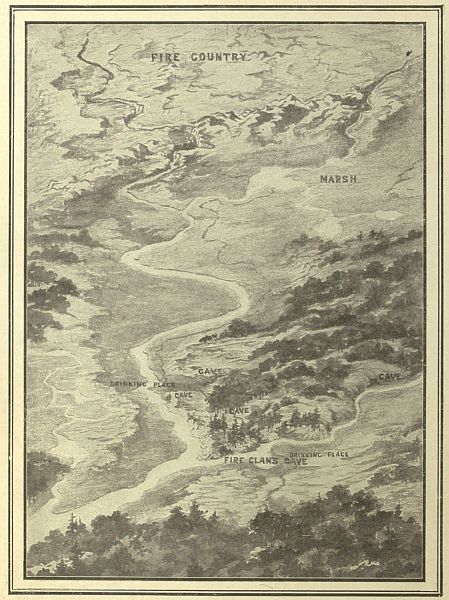
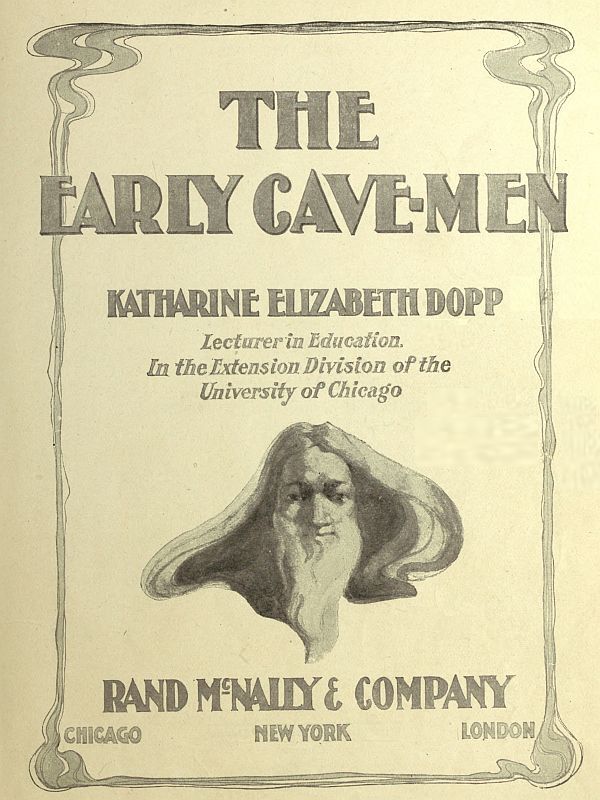
Copyright, 1904
By Katharine Elizabeth Dopp
Entered at Stationers’ Hall
The Rand-McNally Press
Chicago
TO
Dan, Dorothy, Harold, and Jamie
I DEDICATE THIS BOOK

THE series, of which this is the second volume, is an attempt to meet a need that has been felt for several years by parents and physicians, as well as by teachers, supervisors, and others who are actively interested in educational and social progress. The need of practical activity, which for long ages constituted the entire education of mankind, is at last recognized by the elementary school. It has been introduced in many places and already results have been attained which demonstrate that it is possible to introduce practical activity in such a way as to afford the child a sound development—physically, intellectually, and morally—and at the same time equip him for efficient social service. The question that is perplexing educators at the present time is, therefore, not one regarding the value of practical activity, but rather one of ways and means by which practical activity can be harnessed to the educational work.
The discovery of the fact that steam is a force that can do work had to await the invention of machinery by means of which to apply the new force to industrial processes. The use of practical activity will likewise necessitate many changes in the educational machinery before its richest results are realized. Yet the conditions that attend the introduction of practical activity as a motive power in education are very different from those that attended the introduction of the use of steam. In the case of steam the problem was that of applying a new force to an old work. In the case of practical activity it is a question of restoring a factor which, from the earliest times until within the last two or three decades, has operated as a permanent educational force.
The situation that has recently deprived the child of the opportunity[9] to participate in industrial processes is due, as is well known, to the rapid development of our industrial system. Since the removal of industrial processes from the home the public has awakened to the fact that the child is being deprived of one of the most potent educational influences, and efforts have already been made to restore the educational factor that was in danger of being lost. This is the significance of the educational movement at the present time.
As long as a simple organization of society prevailed, the school was not called upon to take up the practical work; but now society has become so complex that the use of practical activity is absolutely essential. Society to-day makes a greater demand than ever before upon each and all of its members for special skill and knowledge, as well as for breadth of view. These demands can be met only by such an improvement in educational facilities as corresponds to the increase in the social demand. Evidently the school must lay hold of all of the educational forces within its reach.
In the transitional movement it is not strange that new factors are being introduced without relation to the educational process as a whole. The isolation of manual training, sewing, and cooking from the physical, natural, and social sciences is justifiable only on the ground that the means of establishing more organic relations are not yet available. To continue such isolated activities after a way is found of harnessing them to the educational work is as foolish as to allow steam to expend itself in moving a locomotive up and down the tracks without regard to the destiny of the detached train.
This series is an attempt to facilitate the transitional movement in education which is now taking place by presenting educative materials in a form sufficiently flexible to be readily adapted to the needs of the school that has not yet been equipped for manual training, as well as to the needs of the one that has long recognized practical activity as an essential factor in its work. Since the experience of the race in industrial and social processes embodies,[10] better than any other experiences of mankind, those things which at the same time appeal to the whole nature of the child and furnish him the means of interpreting the complex processes about him, this experience has been made the groundwork of the present series.
In order to gain cumulative results of value in explaining our own institutions, the materials used have been selected from the life of Aryan peoples. That we are not yet in possession of all the facts regarding the life of the early Aryans is not considered a sufficient reason for withholding from the child those facts that we have when they can be adapted to his use. Information regarding the early stages of Aryan life is meager. Enough has been established, however, to enable us to mark out the main lines of progress through the hunting, the fishing, the pastoral, and the agricultural stages, as well as to present the chief problems that confronted man in taking the first steps in the use of metals, and in the establishment of trade. Upon these lines, marked out by the geologist, the paleontologist, the archæologist, and the anthropologist, the first numbers of this series are based.
A generalized view of the main steps in the early progress of the race, which it is thus possible to present, is all that is required for educational ends. Were it possible to present the subject in detail, it would be tedious and unprofitable to all save the specialist. To select from the monotony of the ages that which is most vital, to so present it as to enable the child to participate in the process by which the race has advanced, is a work more in keeping with the spirit of the age. To this end the presentation of the subject is made: First, by means of questions, which serve to develop the habit of making use of experience in new situations; second, by narrative, which is employed merely as a literary device for rendering the subject more available to the child; and third, by suggestions for practical activities that may be carried out in hours of work or play, in such a way as to direct into useful channels energy which when left undirected is apt to express itself in trivial if not[11] in anti-social forms. No part of a book is more significant to the child than the illustrations. In preparing the illustrations for this series as great pains have been taken to furnish the child with ideas that will guide him in his practical activities as to illustrate the text itself.
Mr. Howard V. Brown, the artist who executed the drawings, has been aided in his search for authentic originals by the late J. W. Powell, director of the United States Bureau of Ethnology, Washington, D. C.; by Frederick J. V. Skiff, director of the Field Columbian Museum, Chicago, and by the author. Ethnological collections and the best illustrative works on ethnological subjects scattered throughout the country have been carefully searched for material.
I wish to take this opportunity to express my gratitude to Professor Dewey for the suggestions he has given me with reference to this series, and to acknowledge that without the inspiration that has come through his teaching I should probably never have undertaken a work of this kind. Among the many friends to whom I am indebted for help and inspiration, I would mention especially, Professor W. I. Thomas and Professor Ella Flagg Young, of the University of Chicago; Superintendent F. A. Manny, of the Ethical Culture Schools, New York City; Mrs. Charlotte W. Williams, of Chicago; my sister, Miss Elspa M. Dopp, of the State Normal School, St. Cloud, Minn.; and Mr. W. W. Charters, of the University of Chicago. To the late Director J. W. Powell, of the United States Bureau of Ethnology, and to Director Frederick J. V. Skiff, of the Field Columbian Museum, Chicago, I am under obligations for courtesies extended which have enabled me to gain access to illustrative materials. For the practical proof that work of this kind is feasible, and that it supplies a genuine need in elementary education, I am indebted to the hearty coöperation of students and fellow-teachers of several states.
K. E. D.
February 1, 1904.

| PAGE | |
| Dedication | 7 |
| Preface | 8 |
| Contents | 12 |
| Illustrations | 13 |
| THE EARLY CAVE-MEN THE AGE OF COMBAT |
|
| PAGE | |
| Why People Wanted to Live in Caves | 15 |
| How the Fire Clan Got a Cave | 18 |
| The First Night in the Cave | 24 |
| How the Fire Clan Got Rid of Sabre-tooth | 27 |
| Preparations for the Feast | 32 |
| The Feast | 35 |
| How the Cave was Made Ready for a Winter Home | 40 |
| How the Cave-men Bored Holes Through Their Trophies | 43 |
| Making New Weapons | 50 |
| How the Women Dressed Sabre-tooth’s Skin | 55 |
| How the Cave-men Made Clothing | 58 |
| The Fire Clan | 60 |
| How the Cave-men Spent the Winter | 64 |
| What the Cave-men Got from the Birch Trees | 66 |
| The Flood | 71 |
| What the Cave-men Lost in the Flood | 79 |
| The Council | 82 |
| The Way to the Fire Country | 88 |
| How Firekeeper Made the Skin Water Bag | 92 |
| Why Firekeeper Made a Door | 96 |
| The Stranger that Came Toward the Cave | 100 |
| The Journey to the Fire Country | 103 |
| The Return from the Fire Country | 107 |
| Strongarm Makes a Great Discovery | 112 |
| How the Cave-men Received Strongarm | 115 |
| The Thanksgiving Feast | 118 |
| What the Women Got from Spruce Trees | 121 |
| How the Women Made Splints for Baskets | 126 |
| How the Women Wove Splints | 130 |
| How the Women Colored their Baskets | 134 |
| How the Cave-men Carried their Burdens | 139 |
| A Mammoth Hunt | 143 |
| How the Cave-men Divided the Mammoth | 147 |
| Strongarm Tells Firekeeper His Secret | 150 |
| How People Know What the Cave-men Did | 155 |
| Suggestions to Teachers | 159 |

| FULL PAGE | |
| PAGE | |
| A map of the Cave-men’s country | Frontispiece |
| “They wished they might have his cave for a home” | 14 |
| “Sabre-tooth was going away” | 19 |
| “She stood trembling so that she could hardly speak” | 22 |
| The Feast | 37 |
| The Flood | 76 |
| “The old man arose in the silence, and thus he spoke to his people” | 84 |
“Then the old man and Sharpeyes took leave of their kinfolk and started out on the long journey” |
91 |
| “They rushed upon him with their knives and spears” | 98 |
| “They carried him into the cave” | 102 |
| “They watched the fire dart up toward the sky” | 105 |
| “They shouted praises to the fire god” | 119 |
| “They broke off slender branches” | 124 |
| Making splints for baskets | 127 |
| “They rested the strap upon the forehead” | 141 |
| A mammoth hunt | 145 |
| “It was here that he showed Firekeeper how to make fire” | 151 |
| TEXT | |
| Firekeeper carrying wood | 25 |
| A flint point | 28 |
| A hunting knife | 28 |
| Fastening the shaft to a branch | 30 |
| Sabre-tooth pinned to the ground | 31 |
| The two large sabre teeth | 33 |
| A stone hammer and stone ax | 34 |
| A gourd | 36 |
| A marrow spoon | 38 |
| Children carrying moss and leaves | 42 |
| Strongarm | 45 |
| A weighted strap drill | 48 |
| A bow drill | 49 |
| Making bones into weapons | 51 |
| Chipping the stones | 52 |
| A hammer stone, with bone handle | 52 |
| Putting handles on the spearheads | 53 |
| A hammer made by Sharpeyes | 53 |
| A handle made of a forked branch | 54 |
| The women dressing skins | 55 |
| Two sides of a scraper | 56 |
| A bone awl | 59 |
| A buckle | 59 |
| A skin cradle | 62 |
| How they rocked the babies | 63 |
| A birch bark basket | 68 |
| A basket with rim | 70 |
| Cave-men watching the river | 73 |
| The cave | 78 |
| How the sandal was worn | 88 |
| A sandal and a tool bag | 89 |
| A gourd | 94 |
| A rhinoceros | 108 |
| Making fire with a strap drill | 112 |
| A drill | 114 |
| The hearth of a fire drill | 114 |
| Strongarm making fire | 115 |
| Cave-men dancing around the fire | 116 |
| Pounding the stems | 129 |
| Woven splints | 131 |
| Firm and strong weaving | 132 |
| A strong basket | 133 |
| Methods of weaving and coloring baskets | 135, 136, 137, 138 |
| How the Cave-men carried baskets | 139 |
| A basket with a handle | 140 |
| A pad for the forehead | 140 |
| A bone whistle | 143 |
| Returning from the feast | 148, 149 |
| A bow drill made into a fire drill | 153 |
| A fire drill | 154 |
| A spearhead | 157 |
| Mammoths | 158 |
| Making a fire drill | 183 |

Did you know that people once lived in caves?
Perhaps you would like to know how it happened.
Long before people lived in caves they lived in the largest trees they could find.
This was before they had learned to use fire.
But after a while they learned to use fire, and they no longer feared to make homes on the ground.
They built brush huts of the rudest kind.
They lived in these huts for many years.
For a long time it was warm on the wooded hills, but after a while it began to grow cold.
The ground was covered with snow and ice.
Cold winds swept over the wooded hills.
Snow beat into the rude brush huts, and cold winds whistled through the branches.
People shivered with the winter’s cold.
They needed a warmer shelter, but they did not know how to make one.
Many of them had been in caves, but they did not dare stay very long.

Some caves were the homes of big cave-bears, others the dens of hyenas.
Sabre-tooth also lived in a cave.
People knew that these animals were dangerous creatures.
Many a time they had barely escaped from the claws of a cave-bear.
Many a time they had been chased by a pack of hyenas.
They did not want to enrage these creatures.

Least of all did they want to enrage old Sabre-tooth.
He was the fiercest creature on the hills.
When he came out of his cave the forest was still.
Scarcely an animal dared stir.
Even the rhinoceros and mammoth feared to attack him.
He was as sly as a cat and as powerful as a rhinoceros.
He had two sabre teeth that were sharp and strong.
No such animal as Sabre-tooth lives now.
There were only a few animals like him then, but they were more feared than any other creature.
He was something like a lion and something like a tiger, but he was more powerful than either.
He did not like to live in the cold, so each winter he went to the south.
Each summer he came back again.
How glad every one was to see him go!
How they hoped he would never return!
How they wished they might have his cave for a home!
Model the wooded hills in your sand box. Make a brush hut to show where the people lived. Show where the caves are.
Tear from paper the animals that lived in caves.
Plan a way of getting a cave for a home.
What happens to the trees and plants just before winter?
What do the animals that you know do before the winter comes?
Do you know what people do to get ready for winter?
Summer was almost gone.
The oak and the birch trees were dropping their leaves, and all the plants were showing signs of the frost.

The wild animals were getting ready for winter.
Some of them were crawling into their holes.
Others were starting for the south.
The fire clan hoped that in a few days Sabre-tooth would go.
They wanted his cave for the winter, so they kept watch of all that he did.
They knew that he slept in his cave all the day and seldom left it except at night.
One morning Strongarm saw him come out of the cave and start off toward the south.
He believed that Sabre-tooth was going away, so he hurried and told his people.
How glad they were to hear such news!
How excited they were as they took their firebrands and followed Strongarm to the cave!
When they reached the cave they paused a moment, while Strongarm crept in through the mouth.
When he was sure that it was safe for them to follow, he beckoned to them with his hand.
One by one they crept through the mouth of the cave, their firebrands lighting the dark way.
It seemed strange to be in such a dark place, but they knew that it was safe and warm.
They all wanted to keep it for a home, but they knew that wild animals would try to get it.
So the women gathered armfuls of branches and started a fire just outside the mouth.
As the fire began to flame up toward the sky, the men gathered around and watched it blaze.
The children played beside the fire or watched their mothers gather branches.
All the people were near the fire when, suddenly, they were startled by a shriek of terror.
Mothers clasped their children to their breasts, and fathers grasped their knives to be ready to fight.
All eyes were soon fixed upon Firekeeper.

She stood trembling so that she could hardly speak, but she pointed toward a thicket.
The men stepped cautiously toward it, but Firekeeper pulled them back.
Then she told them what she had seen.
It was Sabre-tooth trying to come back to the cave.
When the fire clan heard this, they were filled with terror.
They huddled around the fire.
Nobody knew what to do.
Yet everybody knew that something must be done, for their lives were not safe as long as Sabre-tooth was near.
Show how the Cave-men kept watch of the caves of the wild animals.
Show how Strongarm led the fire clan into Sabre-tooth’s cave.
Draw a picture of the people marching to the cave.
Show how the women broke branches of wood and carried them to the fire.
Draw a picture of the women and children gathering wood for the fire.
How do you think the fire clan will spend the first evening in the cave?
Who will be apt to keep watch that night?
At sunset the children were nodding their heads and soon were fast asleep.
The women tended the fire while the men sat around and talked.
All the beasts of prey were out for the night.
Sometimes the fire clan could see their shadows in the open spaces near the cave.
Then they were glad that they had fire.
But they knew that they would have trouble as long as Sabre-tooth was near.
So they began to plan ways of getting rid of him.
They did not dare risk an open fight with such weapons as they had, so they tried to invent a new way.
They planned a long time, but they could not decide what to do.
At length all but Firekeeper crept into the cave, where they were soon asleep upon the rough floor.

Firekeeper stayed beside the fire and kept watch all alone.
She was the oldest woman of the clan, and people said that she was the daughter of the fire.
She always kept it burning.
As she tended the fire through the long night she heard all sorts of sounds.
Once a big cave-bear passed close to the cave, but he sniffed and ran when he saw the fire.
Then a pack of hyenas crept up toward the cave.
They seemed to be looking for a safe place to rest.
But as soon as they saw the fire they ran.
Other animals, too, ran when they saw the fire.
Firekeeper was not afraid when she was near the fire, but it seemed that the long night would never end.
When at last the sky became red in the east, she knew that morning was coming again.
At the break of day all the people awoke.
It was only a few minutes before they were ready to take up the work of another day.
Show how the children fell asleep. Draw a picture of them.
Show how the cave-bear acted when he saw the fire. Draw the picture.
Show how Firekeeper kept watch during the night. Draw a picture of her as she was keeping watch.
Get up early some morning and watch the sun rise. Paint a picture of a sunrise.
Do you know what kind of weapons the fire clan had at this time?
Why would it not be safe for the fire clan to attack Sabre-tooth with such weapons?
What kinds of weapons can you make of stones and sticks?
What do you think the fire clan will do to get rid of Sabre-tooth?
Do you think that the fire clan ate three meals together each day as we do?
As soon as the sun was up, messengers started from the cave to ask the people on the hills for help.
Nobody stopped to eat breakfast.
The Cave-men never ate breakfast together.
Each ate by himself such food as he could find.
Everybody was watching for Sabre-tooth.
Soon Sharpeyes saw him crawl into a thicket, where he laid himself down and went to sleep.

Then the messengers returned with the people from the hills.
They went to the thicket to see Sabre-tooth, but they did not dare attack him.
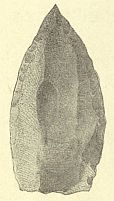
They had learned to put handles on their flint points, so as to make good hunting-knives.
But the handles were short, and it was not safe to attack Sabre-tooth with such weapons.
Their axes and hammers were larger and stronger, but they were afraid to use them now.
While they were all wondering what to do, Strongarm went to look at Sabre-tooth again.

The creature had feasted all night long and was sleeping heavily.
He was lying just under a strong spreading branch of an old oak.
When Strongarm noticed this his eyes brightened.
He motioned to an old man to come to him.
After a few minutes they went back to the other men.
All crowded around, for they felt sure that Strongarm had thought of a new plan.
Then Strongarm showed the people what he wanted them to do.
Everybody was eager to help.
The women brought out all the skins that they had.
Strongarm laid the strongest skin aside and told the women to cut the others into straps.
Some of the men began to work upon large flint points.
Others cut a tough branch of oak and made it into a large shaft.
When all had finished their work, they brought what they had to Strongarm.
He selected the largest and strongest flint point and bound it to the end of the shaft.
He folded the skin so as to make a bag.

Then he tied the skin bag to the shaft.
The boys brought stones to fill the bag and laid them on the ground.
Everything was now ready, so Strongarm took the new weapon over his shoulder and climbed into the oak tree.
Others followed with stones and straps.
Strongarm quickly fastened the upper end of the shaft to the spreading branch of the oak.
Then he carefully filled the skin bag with stones and let the weighted spear hang over Sabre-tooth.
He motioned to the men to go back to the cave, and was soon all alone with Sabre-tooth.
He did not stop to think what might happen.
He grasped his stone knife and began to cut the heavy strap.
When he had cut almost through the strap, it snapped.

The spear fell with its heavy weight and pinned Sabre-tooth to the ground.
Sabre-tooth made one desperate effort to escape.
Then he lay perfectly still on the ground.
How thankful the Cave-men were!
They had one less creature to fear.
They now felt that they would be able to keep the cave for a home.
Notice how gracefully the cat moves. Notice how it gets ready to spring.
Think of an animal many times larger than the cat and see if you can model Sabre-tooth in clay.
See if you can find good stones for hunting-knives and spears.
Name a tool or a machine that you have seen in which a weight is used.
Draw a picture of it.
What do you think the Cave-men will do with Sabre-tooth’s skin?
What will they do with his teeth and claws?
What will they do with his flesh?
Can you think of what they might do with the bones?
How do you think they learned to cook food?
How excited all the people on the hills were when they knew that Sabre-tooth had been killed!
Everybody wanted to see him.
Young and old crowded around to see the monster as he lay stretched out on the ground.
They gazed at the creature in silence.
They admired his rich tawny stripes.
Not a man on the hills had ever before been able to get such a skin.
They all wished that they might have it, but they knew that it belonged to Strongarm.
They examined the two large sabre teeth.
They felt of the smaller teeth and claws.
At length the men began to quarrel about the trophies, but Strongarm waved them back.
He claimed one sabre tooth for himself and allowed the other to go to the brave old man.
When Strongarm spoke the men kept silent, for they knew that the trophies belonged to the bravest men.

But they were given a share in the smaller teeth and claws.
While they were loosening them with stone hammers, the women were hunting for their stone knives.
They were soon busy taking off Sabre-tooth’s beautiful skin.
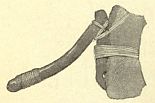
When the heavy skin was off, they began to get ready for the feast.
They ate pieces of raw flesh as they worked, and tossed pieces to the men and boys.
They were all too hungry to wait for the feast.
Besides, they were used to eating raw meat.
But they had learned how to cook meat at this time.
They had learned to roast meat in hot ashes.

At first they roasted the animal in its skin, but now they knew a better way.
They skinned the animal and cut out the ribs; then they buried them in the hot ashes.
They covered the ashes with hot coals.
They cut slices of meat with their stone knives and put them on roasting sticks.
Then they held these sticks over the hot coals just as we sometimes do to-day.
Make believe that you are doing some of the work that the Cave-men did, and see if any one can guess what it is.
See if you can cook something over the coals.
Ask some one to read you a story that Charles Lamb wrote about roast pig.
How do you think the Cave-men would act at a feast?
What would they use for dishes?
What would they do to entertain themselves and their neighbors?
When would the neighbors go home?
Nobody knew just when the feast began.
Nobody set the table, for there was no table to set.
But the women brought bowls they had made out of hollow gourds.
Before the meat was half cooked everybody was eating.

Some ate thick slices that had been partly roasted on the sharp sticks.
Others chewed raw meat from bones which they tore from the carcass.
The children sucked strips of raw meat and picked the scraps from the ground.
When the women lifted the ribs out of the hot ashes, they found a nice gravy.
They dipped up the gravy in their gourd bowls and gave it to the men.
Strongarm dipped some up with a bone dipper that had been made from the skull of a cave-bear.
Then he tore out a rib from the carcass and gnawed the meat from the bone.


They all held what they ate in their hands.
They all ate very fast, and they ate a long time.
At last their hunger was satisfied, and they began to crack the marrow bones and scrape the marrow out with sharp sticks and bones.
When the men became tired of sucking the bones, they tossed them to the women and children.
Then the men joined in a hunting-dance while the women beat time with the bones.
The women chanted, too, as they beat time.
They danced until all became tired and the visitors were ready to go.
Then Firekeeper loaded pieces of meat upon the backs of the women, and all gathered around to see the neighbors start home.
As soon as they were gone the Cave-men prepared to rest for the night.
Take turns in doing something that the Cave-men did at the feast, and let the children guess what it is.
Find some good marrow bones and crack them.
Find out whether we use marrow bones for anything to-day.
If you think that you can, make something of the marrow bones.
Can you think why bones are filled with marrow?
See if you can beat time with marrow bones so as to help some one do his work.
See if you can make dishes of pumpkins, squashes, melons, cucumbers, or anything else that you can find.
If you were going to live in a cave that had been taken from a wild animal, what would you do to make it comfortable?
What do you think the Cave-men did?
What do you think the Cave-men found in the cave?
What kind of beds do you think they made?
If they built a fire inside the cave do you think that the smoke would pass out?
Where do you think that they would make their fireplace? Where do we make our fireplaces?
How do we keep the smoke from getting into our rooms?
The morning after the feast Firekeeper built a fire inside the cave.
Then all went in to look at the cave, but the smoke soon drove them out.
So Firekeeper raked out the fire with a branch of spruce wood and waited for the smoke to go out.
Then the Cave-men took firebrands and crept inside, and stood up and walked around.
Bones of animals were strewn upon the rough rocky floor.
Pieces of rock shaped like icicles hung from the roof and stood up from some parts of the floor.
Drops of water trickled down from the roof.
Layers of rock jutted out from the walls like shelves.
The Cave-men walked through the large dry cavern until they came to a narrow passage.
Then they stopped to see where it led.
They peered into the darkness, but saw nothing.
They listened, but heard no sound.
Since no one wanted to creep through the passage, they turned back toward the mouth.
The dry cavern near the mouth was large enough for a home, so the Cave-men thought no more of the narrow passage.
Before the men went out of the cave they picked up armfuls of bones for weapons.
They carried them out by the fire and sat down and worked upon them.
The women cleared away piles of bones, so as to make a smooth place to sleep.
Then they went out among the trees to find something to cover the floor.
They broke off small branches of evergreens and carried them into the cave.
The children brought armfuls of moss and leaves, and scattered them over the hard rocky floor.
When the beds were finished they made a fireplace.
They dug a shallow hole just outside the cave and walled it around with stones.
Perhaps you would not call this a good fireplace, but it was the best fireplace any one had at that time.

Visit a cave when you have a chance to do so.
Collect pictures of caves.
Model a cave in clay or make one in the ground.
Find out what caves are used for nowadays.
Make a fireplace out of doors and cook something in the hot ashes.
What do you think the beads you wear are made of?
Can you think how they were made?
What do you think the Cave-men used for beads?
What did they wear for ornaments besides beads?
Can you think how they bored holes through their ornaments?
What does the carpenter use to bore holes with?
How does the woodpecker bore holes?
For several days after the feast the Cave-men did not hunt.
As long as they had meat they stayed near the cave and worked upon their trophies.
They were trying to bore holes through the teeth and claws, so as to string them and wear them for ornaments.
Strongarm was working upon the big sabre tooth.
When he had worked for some time, the Cave-men gathered around to see how deep a hole he had made.
Some of the men said that he never could do it, but others thought that it could be done.
Strongarm was tired, so he rested a while and talked to the people about boring holes.
He told what he had heard when he was a boy.
All the grown people had heard what he said many times, but they were always ready to hear it again.
Besides, they wished their children to hear it.
So old and young gathered around to hear what Strongarm said.
They all looked and listened as Strongarm showed the children how to make holes with awls.
As he spoke, the people picked up thorns or sharp bones and punched them through some object.
Then Strongarm showed them a bone awl that he had made to punch holes through seeds and thin shells.

But they could not punch holes through teeth and claws, so they learned to twirl the awls in their hands.
Strongarm did not know how people learned to do this, but he thought that they learned it when at play.
He took a round stick that had a sharp point and twirled it back and forth on his thigh.
The other Cave-men twirled, too, for they wanted to show the children how to bore holes.
The children soon learned how to do it.
Then Strongarm told them of a kind of wood whose surface was coated with sand.
He told of awls and spindles that were made of this wood and used to bore holes through teeth and claws.
Such wood as this could not always be found, so people used other stems.
They tried to find something that was hard enough to bore the teeth and claws.
Sometimes they used sand with a spindle of wood.
At other times they fastened a hard flint point at the end of a wooden spindle.
When they used the sand in boring, they no longer twirled the spindle on their thighs.
They could not use the sand unless they held the spindle upright.
Strongarm showed them how it was done, and all the people tried it.
It was hard work for one person to twirl the spindle steadily.
So they began to twirl in an easier way which they had learned when they were young.
Strongarm and Sharpeyes worked together, and the others worked in the same way.
When Strongarm’s hands were near the foot of the spindle, Sharpeyes’ hands were near the top.
As Sharpeyes’ hands began to move down the spindle, Strongarm began again to twirl at the top.
Sometimes they were awkward in moving their hands.
Then the spindle did not work so well, so they tried to keep the same time with their hands.
They worked together best when they sang as they worked, and the singing kept them from getting tired.
Once when they stopped to look at their work, Strongarm picked up a strap that was on the ground.
He carelessly wound it once around the spindle, keeping hold of one end of the strap.
Then Sharpeyes picked up the other end of the strap, and Strongarm jerked the end that he held.

They did this a few minutes just in play, but at last they began to do it in earnest.
Strongarm placed the end of the spindle in the shallow hole that he had made in the sabre tooth.
Then he and Sharpeyes began to twirl the spindle with the strap.
But there was nothing to keep the spindle from falling.
So they tried to hold it with a piece of wood.
They made a shallow hole in the wood to fit the top of the spindle.
Then while Strongarm and Sharpeyes pulled the strap, a boy held the spindle in place.
Soon the spindle was working steadily, and the hole was becoming deeper and deeper.
When they had bored a hole halfway through the tooth, they began to bore from the opposite side.
All the Cave-men came up to see them work.
As soon as the hole was made, Strongarm took a cord of braided sinew and hung the sabre tooth at his side.

After that he always wore the trophy.
Sometimes he used it for a knife and sometimes for a saw.
Every one who saw this rare trophy knew that Strongarm was a brave man.
Make a collection of things that you can use for awls.
Find something that will do for the spindle of a drill.
Show how to drill a hole by twirling the spindle or awl on the thigh.
Show how one person can twirl an upright spindle.
Show how two persons can twirl an upright spindle with their hands.
Show how they can do it with a strap. Can you think why stones are sometimes bound to the shaft of a drill?
Look at the picture of the bow drill and see if you can make one.
Draw a picture of the Cave-men working upon their trophies.
Think of as many tools and weapons as you can that the Cave-men found ready to use.
What could they find to make into tools and weapons? Why did they not use large boards and metals?
Why did they put handles on their tools and weapons?
Think of as many ways as you can of fastening handles to tools and weapons.
The Cave-men liked their new home.

They were able to work better when they were warm than when they were shivering with the cold.
They found more time to improve their tools and weapons.
One day they began to make weapons of the bones they found in the cave.
Many of the bones were good for clubs.
Others were good for handles of weapons.
After the Cave-men had sorted out the bones that they wanted, they went to hunt stones along the margin of the stream.
They wanted stones that were good for hammers.

So they hunted for smooth, round stones that were hard to break.
They wanted other stones for knives, spears, and axes.
So they hunted for stones that broke with a sharp edge.
They struck the sharp edges with hammer stones to see if they crumbled under a heavy blow.
When they found stones that crumbled they threw them away, but they kept the stones that were tough and strong.
When they had chipped off a few large flakes they carried the rough stones to the cave.
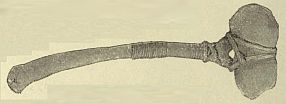
There they made them into weapons.
They did not chip the hammer stones, but fastened handles to them.
Some handles were long bones that were large at the joint.
Other handles were made of forked branches.
Sharpeyes found a hammer stone with a groove around the center and fastened a handle to it.
He cut a slender branch of a sapling and bent it around the groove.
Then he twisted the ends and held them close, while he bound them with rawhide.

The Cave-men liked this hammer so well that they made other hammers like it.
They made long handles for their knife points, so that they became real spears.
They put handles on the spearheads in many ways.
Sometimes they bound the spearhead between the split end of a long stick, and covered the binding with pitch.
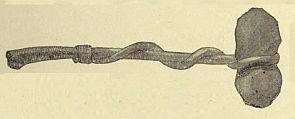
Sometimes they drove the spearhead into the soft part of a large horn.
Sometimes they drove it into the pith of a branch.
They always tried to bind the handle so that it would stay, for they sometimes got hurt when a handle came off.

Find stones that will make good hammers. Tell why they are good for hammers.
Find stones that are good for knives, axes, and spears. Tell why they are good for such weapons.
Find bones, horns, or sticks that are good for handles. See if you can put handles on hammers or spears.
Notice how handles are put on tools nowadays.
Show as many ways as you can of fastening handles to tools and weapons.
See if you can find a tool whose handle is fastened in a way that the Cave-men did not use.
Tell where you can find the best stones for tools and weapons.
Why do people not use stones for tools nowadays?
Find out what small stones are used for to-day.
How do you use stones?
What do you think the women were doing while the men were working on their weapons?
What tools and weapons did the women need? Do you think that they made them themselves?
While the men worked upon their trophies and weapons, the women, too, were working.

They had gone to the river banks to get stones to make into tools.
They were ready to dress old Sabre-tooth’s skin, so they hunted for stones that would make good scrapers.
They shaped the stones by chipping them with hammer stones, but they did not make handles for them.
If the rough edges hurt their hands, they wrapped the scraper in a piece of skin.
When the scrapers were ready, they found a smooth spot where they stretched out Sabre-tooth’s skin.
Then they made little slits all around the edge and drove little pegs through them.
They scraped off thin shavings from the inner side, but they were careful not to spoil the skin by cutting through it.
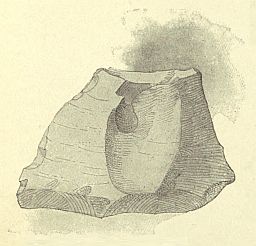
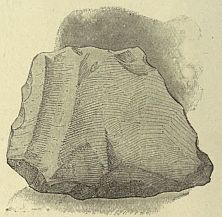
When they had a smooth surface, they rubbed it with fat so as to make it soft.
Sometimes they chewed the hard parts to make them soft.
When the skin was smooth and soft, they dried it in the sun.
Then they took it into the cave.
Sabre-tooth’s skin was too large to wear every day, but Strongarm wore it on feast days.
Show how the women stretched the skin upon the ground.
Show how they scraped it and rubbed it with fat.
Find a stone or a shell that will make a good scraper.
Get a skin at the meat market and see if you can dress it.
Name things that you wear that are made of fur.
Name things made of fur that men and women wear.
Find as many other uses of fur as you can.
Where does the fur that we use come from? Ask some one to tell you how it is prepared for use.
Can you think why fur is more expensive now than it used to be? Why should we be careful about killing wild animals?
Name the things you have that are made of leather.
Visit a tannery and ask some one to tell you about it.
Draw a picture of the women dressing Sabre-tooth’s skin.
Why did the Cave-men need more clothing than the Tree-dwellers had?
Do you know whether they had cloth? What could they use instead of cloth?
How do you think they sewed?
How many ways do you know of lacing up your shoes?
What did the Cave-men use instead of scissors?
What do you think they used for needles and thread?
During the summer the Cave-men did not wear much clothing.
They dressed about the same as the Tree-dwellers.
When they were in the cave, they did not need clothing, for it was always warm in the cave.
But, as winter came on, they were cold when they went out to hunt.
Sometimes they tried to keep warm by running, or by swinging their arms.

The skins that they wore for trophies also helped them to keep warm.
But, as it grew colder, they began to wear larger skins.
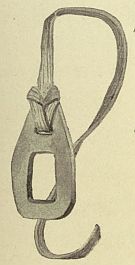
If they could not find a skin that was large enough, they pieced small skins together.
Where we would use scissors, they used a stone knife.
Where we would use a needle, they used a bone awl.
They trimmed off the ragged edges and punched holes in the places they wished to sew.
Then they laced them together with sinew thread, as you lace up your shoes.
They fastened the garment over the shoulder by tying it with strong straps.
Sometimes they fastened their garments with buckles.
These skin garments covered only part of the body, but they helped the Cave-men keep warm and strong.
See if you can find things such as the Cave-men used to make a dress for your doll.
Find as many ways as you can of sewing by using an awl instead of a needle.
See if you can find sinew or tough roots and grasses for making thread.
Can you think why the Cave-men lived in clans instead of in families as we do?
How many men do you think lived in the fire clan? How many women? How many children?
What could the children do to help their fathers and mothers?
How do you think the children played?
Ever since the Tree-dwellers had learned to use fire, there had been a fire clan on the wooded hills.
There were many other clans, too.
Some of them were named after wild animals, and some were named after plants.
All the people lived in clans, for it was the best way to live at that time.
There were enough men in each clan to protect it from wild beasts.
There were enough women to do the household work.
There were many children, too.
But there was room enough in the cave for all, and they lived as if they were one large family.
Each child in the clan was given a name, which was changed when he became full grown.
The name of one of the girls was Brighteyes.
Brighteyes called every man in the cave her father, and she called every woman her mother.
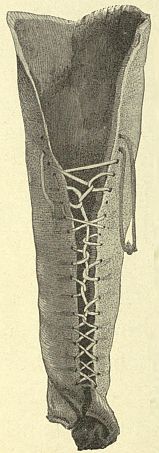
All of the children were her brothers and sisters.
She did not have any cousins.
She did not have any uncles and aunts.
At that time no one spoke of uncles and aunts.
Brighteyes used to play with her brothers and sisters, and she used to work, too.
She tried to do what the grown people did.
Sometimes the children went with their mothers to hunt for roots and nuts.
But sometimes they had to stay at home to take care of the babies.
Brighteyes liked to play with the babies.
She would hunt for bright and shining playthings, which she strung on spruce root or a kind of tough grass.
Then she would dangle them over the heads of the babies and watch them as they laughed and crowed.

Sometimes the girls made rattles of gourds, which the babies played with for a long time.
Sometimes they carried the babies on their backs until they got very tired.
Then they put them in their skin cradles again and hung them on the branches of a tree.
While they rocked the babies in their cradles they sang them little lullabies.
Make some playthings for a baby that you know.
See if you can make a skin cradle for your doll.
How do you think the Cave-men spent the winter?
What kind of food do you think they ate?
What do you eat in the winter?
Why could not the Cave-men have as many kinds of food as you have?
Do you think you could stand it to go out in the cold dressed as the Cave-men were dressed?
Perhaps you think that the Cave-men spent a dreary winter.
It might be dreary for you if you had to spend it that way.
But the Cave-men knew nothing about such homes as we have.
They lived in the very best home that anybody had at that time.
That is why they were satisfied.
When the weather was pleasant they went out to hunt, but they never had to go far.
The wild animals were not yet afraid of men, and so they did not try to get away.
By using their spears and stone axes, the Cave-men got plenty of meat to eat.
But they got so hungry for something green, that they ate the green moss that they found in the stomach of the reindeer.
Sometimes they ate the inner bark of trees.
Sometimes they found nuts in squirrels’ nests, but most of the food that they ate was meat.
In the coldest weather they did not have even meat, for it was not safe to hunt in the biting cold.
They stayed in the cave for days at a time without a taste of food.
Sometimes they were so hungry that they chewed hard skins, and they even sucked dry bones.
But they managed in some way to live through these cold days, until the weather became warmer again.
Think of the coldest and stormiest day you have ever seen, and draw a picture showing how it looked.
Tell a story of what Brighteyes did during a cold day.
Tell a story of what the Cave-men did one pleasant day in the winter.
Have you ever noticed the bark of a birch tree?
Do you know what birch bark is used for?
Why is birch bark better to make into baskets and boats than the bark of other trees?
Can you think of a way of taking birch bark from a tree without splitting the bark?
Have you ever seen bark that has been mended?
What do you think the Cave-men used birch bark for?
Why do you not have the right to peel birch bark from any tree that you see?
Are there any birch trees that you do have the right to take bark from?
When the snow began to melt, the Cave-men were glad; for it was warm enough to leave the cave.
They spent their days on the wooded hills where many birch trees grew.
All the Cave-men liked to go to these trees.
They liked to peel off the silvery white bark that hung from the older trees in strips.
They wanted to get the tough inner bark that was under the smooth outer coat.
They chewed the inner bark the way you chew gum.
Sometimes they bit into the bark with their teeth, and sometimes they cut it with a stone knife.
Then they peeled it off in strips with their fingers.
At first they peeled it carelessly and gave no thought to the width of the strips.
But one day Firekeeper peeled off a wide strip.
There were narrow strips for her to eat, so she kept the wide strip for a while.
One day she began to shape it with her hands and to fold in the edges.
After trying for a long time, she made it into a basket.
She did not cut the bark, but shaped it by making folds in each corner and fastening them with sharp thorns.
She gathered winter buds into the basket and carried them home to the cave.
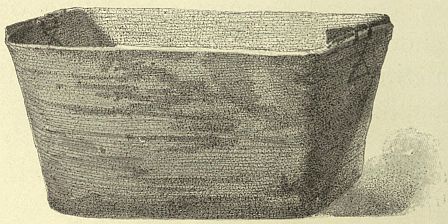
In a few days the thorns fell out, so Firekeeper cut the bark and sewed the folds.
But this basket did not last very long.
The edges split and Firekeeper’s basket was soon worn out.
One morning she went with the other women to get birch bark for another basket.
They had no trouble in cutting the bark and in loosening the edges with their fingers.
But as soon as they tried to peel it, the bark began to split.
So they tried to press evenly with their fingers against the under side, but still many strips split.
Finally Firekeeper picked up the rib of a deer and pressed it under the loosened edge.
Then she carefully pulled the ends of the rib and peeled off a large piece of bark.
Then all the women tried to peel bark by using the rib of a deer.
They carried the bark that they peeled to the cave, and sat down by the fire to make baskets.
Nobody was satisfied with Firekeeper’s basket, for the corners were rough and the edges split.
They found that by cutting into the sides of the bark they could fold it so as to make smoother corners.
So they cut and folded the bark, then sewed the folds with spruce root.
Then they hunted for something to bind around the edge, so as to strengthen the basket.
Some of the women made rims of tough grass, and some used willow stems.
These were the first rims they had ever made, but the women always put rims on their baskets after that.
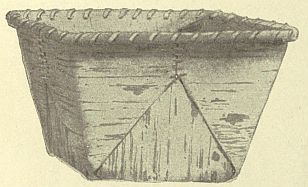
If there is a birch tree growing in your neighborhood, go and see it.
Notice whether it is a good shade tree. Does the bark on the young trees hang in strips as it does on the older trees?
If you have the right to do so, peel off enough birch bark to make a basket, a boat, or a frame.
When you visit a museum, find as many things as you can that are made of birch bark.
Find pictures of things that are made of birch bark.
When the snow melts in the spring, what happens to the river or stream in your neighborhood?
How does the melted snow get to the river?
Have you ever heard of rivers that are under the ground?
If such a river-bed were dry, what would it be?
Have you ever seen a ravine? Is it anything like a cave?
If the roof of a cave fell in, what would the cave become?
If the sides of a ravine became worn down, what would it become?
Think of ways in which the cave might be flooded when the snow melts in the spring.
Do you know anything about the floods that we have nowadays?
Winter was almost gone.
The air was getting mild and soft.
The snow was beginning to melt, and the river was rising.
All along the banks there were mountains of snow and ice.
Huge masses of floating ice were carried along by the current.
The Cave-men were watching the swiftly rising river.
They feared that there might be a flood.
The children were playing in the melting snow and wading in the water.
Sharpeyes had just come from the ravine.
This ravine was usually dry in summer, but in winter it was filled with snow.
Now it was a deep, dark stream, with black and threatening water.
All the ravines were pouring their waters into the river, which was rising rapidly.
Where the banks were steep the river was narrow.
There the water was deep, and large masses of snow and ice were carried along by the strong current.
At the drinking-place the banks were low.
There the river was wider and the current was not so deep and strong.
Small masses of snow and ice were carried along by the current, but the larger masses became lodged on the bed of the stream.
In this way the river was forming a dam.
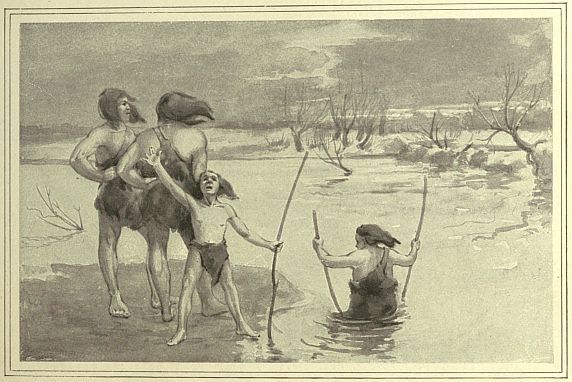
All day long the Cave-men watched the river, but at night they went back to the cave.
There were dark clouds in the sky; so Firekeeper covered the fire with ashes, and they got ready for the night.
All but Firekeeper were soon asleep.
As she kept watch that night there was something that troubled her.
It was not the roaring river.
It was not the pouring rain.
She had heard those sounds before.
It was a sound that was new to her, and she wondered what it meant.
It seemed to come from deep down in the cave, and sounded like rumbling water.
She did not wish to frighten the clan, so she let them all sleep.
She listened again.
She still heard the roaring of the river.
She still heard the pouring rain.
Below it all she heard that strange muffled sound.
It was coming nearer and nearer.
She felt water trickling over her bed of moss and leaves.
At first she thought it was the rain.
She peered into the darkness, but saw nothing.
She felt of the running water.
It was coming from the cave.
Then she called Strongarm.
He quickly roused the people, and they hurried out of the cave.
A moment more and it would have been too late.
The water rushed up from the dark narrow passage and out through the mouth of the cave.
There was water everywhere.
The frightened Cave-men ran for the hills.
They climbed trees, where they stayed through the long dark night.
When the rays of the sun streaked the sky in the east, the Cave-men were still up in the trees.
They looked out over the valley, but they scarcely knew the place.
All the land except the hills was covered by the flood.
All the thickets had disappeared.
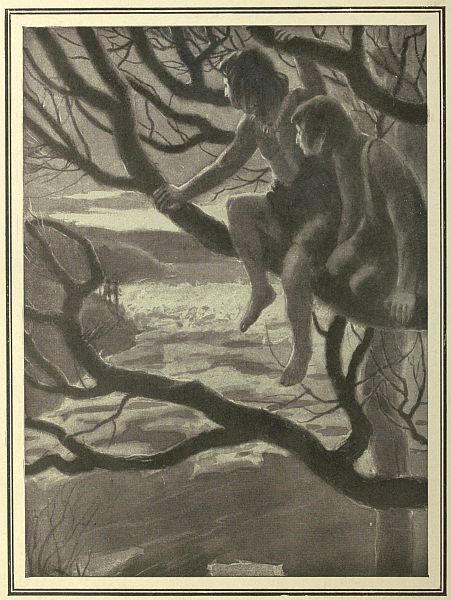
Only the tops of the trees stood above the water.
The river was dammed with snow and ice.
The water dashed against the dam, but it could not break its way through.
It was forced back; it was overflowing the banks; it was flooding the land.
Nobody had breakfast that morning.
Nobody had a mouthful to eat all that day.
All the Cave-men watched the flood from the trees.
They heard the ice when it began to crack.
They heard the roaring of the river as it beat upon the dam.
They knew that it was wearing its way through.
About midday there was a loud crash.
The Cave-men then knew that the dam was broken.
They saw the water pour through the dam and sweep everything in its path.
Before sunset the flood was gone.
Most of the ice and snow had been swept away.
The Cave-men were glad to come down from the trees, and they hurried to see what had happened to their cave.

Notice a river or brook after a heavy rain or the melting of the snow.
See if you can tell where the current of the river is.
Notice the difference in the current in the wide and narrow parts of the river.
Find the parts of the valley that would be flooded if the river overflowed its banks.
Notice the little holes that are made in the ground by the rain.
See if you can find a ravine made by the rain.
Model a small river valley showing some of the work of the rain.
Change the little pot-holes so as to make them into caves.
Change the caves so as to make them into ravines.
Change a ravine so as to make a valley.
Tell a story of how a pot-hole became a valley.
Show in your sand box the way the cave was flooded.
Do you think that the Cave-men can live in their cave when they go back?
What do you think they lost in the flood?
What did the Cave-men prize most of all?
Can you tell why they thought the fire was alive?
The Cave-men were anxious about their home, so they hastened to the cave.
Their bare feet left clear tracks in the layer of fine mud.
But they were too anxious about the fire to think of such things as tracks in the mud.
They did not know much about the fire or the flood, but they thought that they both were alive.
They feared that the fire had been driven away.
Yet they hoped to find a few live coals that they could kindle into a flame.
But not even a stone was left on the spot to mark the place where the fireplace had been.
Everything had been swept away by the flood.
Firekeeper searched in vain for a spark.
When at last she knew that the fire was gone, she wrung her hands and wailed.
The people joined in Firekeeper’s cries until Strongarm comforted them.
Strongarm hoped that their neighbors still had fire and sent Sharpeyes to find out.
Then he crept through the mouth of the cave to see what had happened there.
The water had gone down in the large cavern, but it was still rumbling below.
The floor of the cave was wet and slippery and covered with fine mud.
Slowly Strongarm groped his way through the dark and damp cavern.
He wanted to find Sabre-tooth’s skin.
He moved his hands over the floor of the cave and into each corner and crevice.
But no trace of the skin could he find.
Then the Cave-men hunted for their weapons, but they, too, had been carried away.
The Cave-men had lost all they had in the flood.
When they saw Sharpeyes coming they went to meet him, but he brought them no good news.
There was no more fire on the wooded hills.
There was sorrow everywhere.
Show what the Cave-men did when they went back to the cave. Draw a picture of them.
Tell a story of what you think happened at one of the other caves.
How do you think the Cave-men will get fire?
Where can fire be found without making it?
If the Cave-men had seen a place where there were natural fires, do you think they would remember where it was?
What do you think happened to the wild animals during the flood?
The cave was too damp to live in for several days after the flood.
The Cave-men camped at its mouth and waited for it to dry.
Not an animal came near them during that time.
Many animals had been drowned in the flood.
Many more had escaped to higher lands.
The Cave-men were safe for a time, but they had to live on bark and roots.
They knew that the animals would return, so they began to make new weapons.
It was well that they made them as soon as they did, for the animals soon came back.
At first the animals kept away from the cave, but when they no longer saw the fire, they began to come up nearer.
Then the Cave-men were frightened.
Some of them wanted to leave the cave and live as the Tree-dwellers had lived.
But Strongarm wanted to stay in the cave and to keep all the people in the clan together.
He knew that they could not keep together unless they had fire again.
So he talked with the bravest men, and they decided to hold a council.
Messengers were sent to call all the people to a meeting at the fire clan’s cave.
By midday they had assembled.
They had not held many councils.
They were not used to obeying.
At first there was great confusion, and loud and boisterous talking.
Each had a plan of his own.
But soon they became more quiet and began to listen to the wisest men.
All eyes were soon turned toward an old man who had been their mightiest hunter.
But now he was getting old, and his strength was beginning to fail.
The old man arose in the silence, and thus he spoke to his people:
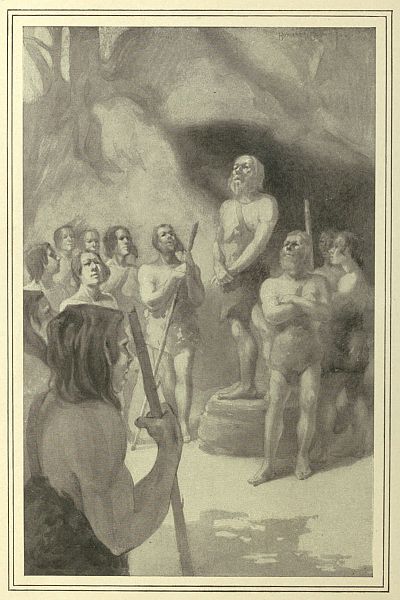
“Many years have we lived on these hillsides.
Our fathers lived here before us.
They lived many years without fire.
They lived, and they worked, and they waited.
The fire god came among them.
He gave them burning branches.
He told them they were his children.
He asked them to feed him daily.
We have always tried to obey him.
We have always fed him daily.
He has given us his protection.
But the water god was angry.
He came in all his fury.
He drove us from our dwelling.
He rushed upon our fire god.
He drove him far away.
Now the water god has gone.
Our fire god may return.
He may be near us now.
We must search till we surely find him.
We must bring him home again.”
For a moment the old man was silent.
He waited for some one to speak.
At last Strongarm asked the old man if he knew where the fire god now lived.
To this the old man responded:
“That no one knows truly.
I have heard that he dwells in the dry wood.
But he seems not to hear our voices.
I have heard that he dwells in the mountains.
Our fathers have been to the mountains.
They were hunting the musk sheep and the marmot.
One night they were tired and hungry.
They were seeking a place of refuge.
They saw a light in the distance.
They ran to it.
They found the flaming fire.
It gave them its protection.
I have heard there are dark chasms.
I have heard that the fire springs from them.
I think I can find these mountains.
But my steps are getting feeble.
I need the help of a young man.
Who will go on this long hard journey?”
Then Sharpeyes stepped forward and said that he would go with the old man.
Everybody knew that Sharpeyes was a brave young man, and so it was agreed that he should be the one to go.
Think of the old man as he talked to the people.
Think of Sharpeyes as he stepped forward and said that he would go.
Draw one of these pictures.
Play holding a council.
When you go traveling where do you stay at night? Where do you think the old man and Sharpeyes stayed?
Where do you get food when you travel? Where would the Cave-men get food?
What new clothing do you need before you go? What clothing do you think the Cave-men needed to get ready to go?
Did the Cave-men need anything that you do not need? Why?
The Cave-men knew that the fire country was far away from the wooded hills.
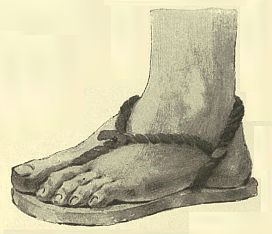
They knew that the journey was a dangerous one, and that the old man and Sharpeyes might never return.
So they did all they could to help them prepare for the journey.
Much of the way was rocky, and they knew their bare feet would blister.
So they tried to make something to protect their feet.
They had not yet learned to make shoes and stockings, but they had often bound grass about their feet.
They had even learned to make braided grass sandals.
They braided the grass, then sewed it.
Braided grass sandals were good while they lasted, but they soon wore out.
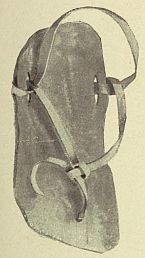
So they made new sandals of thick, tough skin.
Part of the way was through thorny thickets, so they needed something to protect their legs.
They had not yet learned to make trousers or leggins, but they cut strips of skin to wind around their legs.
Skins that were worn as clothing by day served as blankets by night.
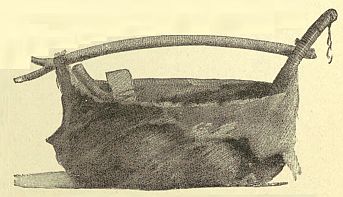
They dared not burden themselves with food, but trusted to killing game on the way.
So they were careful to take their best spears and axes.
They knew that their weapons might break, so they took tools and straps to mend them.
Everybody helped the old man and Sharpeyes.
Everybody arose early the morning they went away.
Sharpeyes and the old man put on their new clothing, and the women brought them food to eat.
As the old man slung a hollow gourd over his shoulder, Firekeeper came up and gave him a skin bag.
Nobody knew what the bag was for until Firekeeper showed them that it would hold water.
The old man was glad to take it and leave the hollow gourd at home.
Then the old man and Sharpeyes took leave of their kinfolk and started out on the long journey.
Make a pair of sandals of something that you can find growing out of doors.
Draw a picture of the Cave-men helping the old man and Sharpeyes get ready.
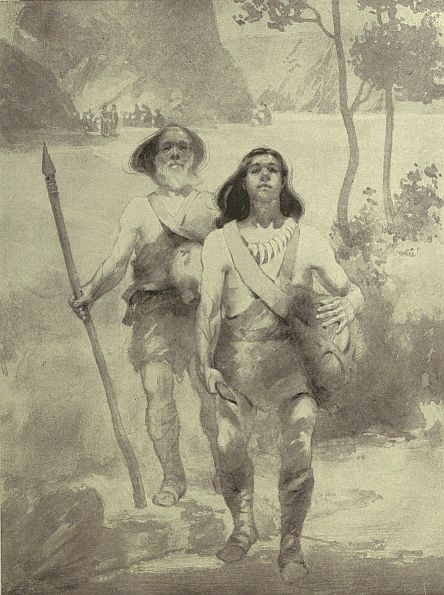
How do you think Firekeeper made the skin water bag?
Where did the Cave-men get water? When did they need to carry water?
Name as many things as you can that they could use for carrying water before they learned to make water vessels.
What do we use to carry water? Where does the water that we drink come from?
The Cave-men watched the old man and Sharpeyes until they passed out of sight.
Then the men went out on the hills, while the women and children dug roots near the cave.
After a while they climbed a large oak tree and sat on its strong spreading branches.
Then Brighteyes asked Firekeeper about the bag, and how she happened to make it.
All the children liked to hear Firekeeper talk.
She often told them of the brave deeds of their fathers.
She often showed them how to make useful things that their mothers knew how to make.
They all wanted to hear her now, so they tried to get close beside her.
She told them of Sharptooth and the way she got water by drinking it from the stream.
Then she told how Bodo got fire, and how people began to live around the fireplace.
As soon as people learned to work together, they often went far away from the stream.
When the women went berrying far from the river, they became thirsty before they got home.
One day they found water in a hollow gourd that had been filled by the rain.
They took the gourd with them when they went home and used it for carrying water.
Afterward they learned to hollow out gourds and to use them for water vessels.
Sometimes they left part of the vine on the gourd and used the vine for a carrying strap.
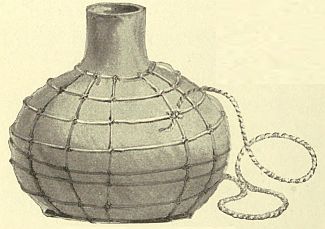
When they pulled the gourd off from the vine, they had to make a strap for the gourd.
Sometimes the gourd broke and spilled the water, so they wove a coarse netting of wild vines and covered it with that.
All the children had seen gourd water vessels and had used them many times.
Brighteyes had learned to make the netting, so Firekeeper did not stop to show how it was made.
All were anxious to hear about the skin bag, so Firekeeper went on with her story.
She told them that she had been thinking of the dry rocky country for several days.
She knew that the men must pass through it, and she feared they would die of thirst.
She was afraid to trust the gourd water vessel at such a time as this.
She wished the gourd were as strong as skin.
Then she wondered if she could make a skin bag.
The next day when she was skinning a hyena she happened to think of a way to do it.
Instead of cutting the skin straight down the breast line, she tried another way.
After cutting off the feet and the head, she loosened the skin and slipped it off almost whole.
She scraped it and softened it with fat, and tied up the legs with straps.
Then she fastened a strap to the bag.
It was finished just in time for the men to take it with them.
The story was now ended, so the women and children got down from the tree and started back to the cave.
Think of Firekeeper and the children as they sat in the tree. Draw a picture of them.
Find as many things as you can that the Cave-men might have used to carry water.
Make a water vessel of a gourd, a melon, or something that you can find.
Perhaps you can ornament your water vessel.
Draw a picture of the skin water bag.
What do you think the Cave-men will do while the old man and Sharpeyes are gone?
How will they keep the animals out of the cave?
The day after the old man and Sharpeyes went away, a cave-bear came up toward the cave.
The women sent the children into the cave and grasped their weapons to help the men.
The bear turned and went away.
But the Cave-men were afraid that he would come back.
They could defend themselves at the mouth of the cave, but they had to go out to get something to eat.
They were afraid to leave the children alone for fear the cave-bear might get them.
At last they thought of shutting them up in the cave.
They had never seen nor heard of a door, but they knew how to heap up piles of stones.
So they rolled up large stones and piled them up until part of the entrance was blocked.
They did not want to wall up the whole mouth, for the stones were too heavy to move every day.
But they wanted to close the mouth of the cave so as to keep the cave-bear out.
Everybody tried to find a way to do it, and at last Firekeeper got an idea for a door.
Perhaps you would not call what she made a door, but it was a good door for that time.
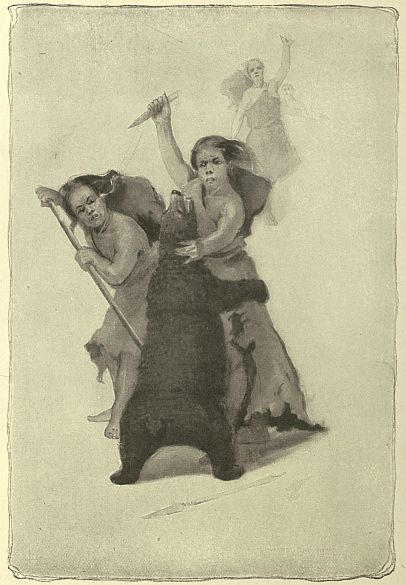
Firekeeper made it of tough branches.
She stuck several large branches into the ground and wove smaller ones among them.
When the door was finished, the women pulled up the large branches and carried the wicker-work door to the cave.
They set it between the stones so as to close the mouth.
After that they shut the children in the cave when they went out to hunt.
But the cave-bear still prowled around.
When the women came home from the woods one day, the cave-bear was at the door.
They rushed upon him with their knives and spears.
They were torn and bruised by the cave-bear, but he never troubled them any more.
If you have a playhouse, try to make a wicker-work door for it.
Tell a story of what the children did when they saw the cave-bear through the holes in the door.
Model a cave-bear in clay.
Can you think what kind of a place the fire country is?
Can you tell where we get oil and gas to burn? If a natural oil well should take fire, what would happen?
Have you ever seen a volcano?
Many days passed, and each day the Cave-men missed the fire more and more.
They missed the old man and Sharpeyes.
They hoped they would soon come home.
But as the days went by and they did not come, the Cave-men feared they would never return.
One day about sunset they went into the cave.
As Firekeeper was fastening the door of the cave, she saw a stranger coming.
She called the others to look.
They hoped they would see their friends, but this man seemed a stranger.
He was hardly able to walk.
His garments were torn and tattered.
His limbs were bruised and bleeding.
As the Cave-men looked in silence, he sank exhausted to the ground.
Then the Cave-men gathered around him.
They raised him up and looked into his face.
They could scarcely believe what they saw.
It was Sharpeyes.
No wonder they did not know him.
He had been one of their bravest hunters.
He had left them young and happy, but now he looked old and haggard.
He seemed to be crushed with sorrow.
They carried him into the cave and bathed his tired feet.
They dressed his wounds.
At last he moved, and they spoke to him.
They asked about the old man.
They asked if he had found fire.
But Sharpeyes could not answer.
He fell into a deep sleep, and he was still sleeping long after the morning sun arose.
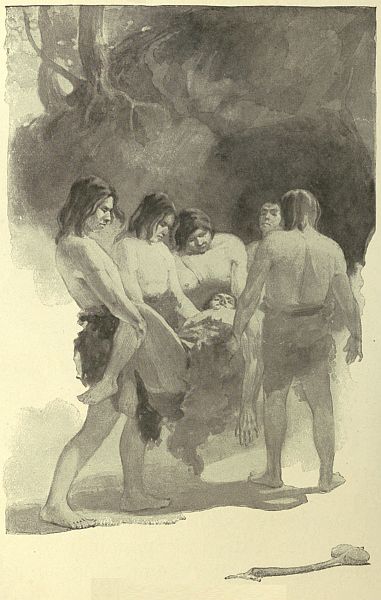
Show how the Cave-men acted when they saw the stranger coming toward the cave.
Show how they helped Sharpeyes to the cave.
Draw a picture showing the part that you like best.
What do you think the Cave-men will do while Sharpeyes is sleeping?
Why will everybody on the wooded hills want to hear his story?
What do you think his story will be?
Before sunrise Strongarm had sent word to all the people on the hills that Sharpeyes had returned.
He told them to meet at the fire clan’s cave.
All were anxious to hear Sharpeyes’ story.
Some of the Cave-men still hoped that the old man would come with fire.
But others feared he would never return.
About noon Sharpeyes awoke.
The women brought him water and meat.
When he had eaten, all the Cave-men were there.
They gathered around Sharpeyes in silence and grew sad as they looked in his face.
At length Sharpeyes roused up as if he were waking from a dream.
He recalled the morning that he and the old man had started out on their journey.
He spoke of the hope that filled their hearts.
He told of the long and difficult way and of the trouble they had in crossing the mountains.
At last they reached the dry, rocky country, where the old man led the way.
He knew where to look for the cool mountain springs, where they drank and filled the water bag.
They journeyed onward many a day, climbing steep and rocky heights.
At last they saw flames of fire in the distance.
They eagerly hastened to their journey’s end.
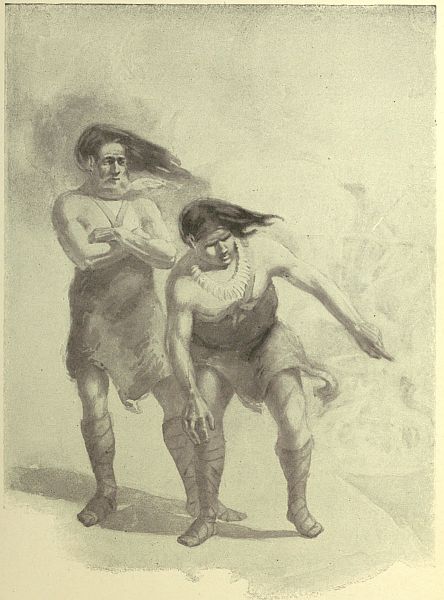
They were tired and hungry when they reached the fire country, but their hearts were filled with joy.
They were glad to be near the fire god once more.
They watched the fire dart up toward the sky.
It seemed to come from deep, dark chasms.
They stayed in the fire country several days.
After mending their weapons, they hunted a while.
They cooked their meat in the flaming fire.
They slept on the ground beside the fire.
When they were rested they started home.
They lighted some punk and put it in their tool bag.
Then they lighted their torches and set out on their homeward way.
As they traveled they talked of their friends.
Their hearts were glad, for they hoped to bring happiness to all the people on the wooded hills.
Play that you are the Cave-men, and let some one tell Sharpeyes’ story while the others listen to it.
See if you can find some punk. Why do you think that the men put punk in their tool bag?
Tell all that you know about the fire country. Draw a picture of it.
What do you think had become of the old man?
How do you think the Cave-men will get fire?
While Sharpeyes was talking he seemed to be hopeful.
But now his head fell, and he seemed unwilling to speak.
Strongarm urged him to go on.
At length he continued the story, but his voice was filled with sadness.
He told how the first few days of their journey everything went well.
They stopped for nothing but food and sleep, for they were anxious to get home.
No animal disturbed them on their way as long as they had fire.
But one day the sky grew dark.
A heavy rainstorm beat down upon them and put out the fire they carried.
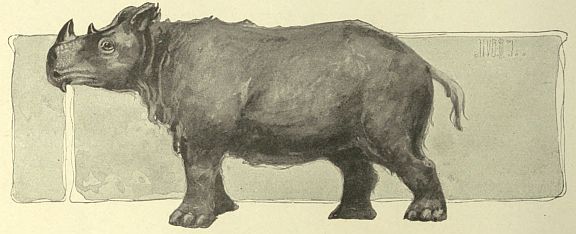
But since they had burning punk in the bag, they thought they could light their torches again.
They waited for the rain to cease.
Then they took the punk from the bag and tried to light their torches.
But the wood was damp, and it was hard work to fan the spark into a flame.
They worked so busily that they thought of nothing except the fire.
They did not see a big-nosed rhinoceros that was watching them from among the trees.
He was almost upon them before they thought of danger.
Then they quickly sprang for the tree, but the old man lost his hold.
He fell and was trampled by the monstrous beast.
The rhinoceros tore up the ground with his horns until he had spent his rage.
Then he tramped off through the woods.
Sharpeyes paused again.
His voice choked, so that he could scarcely speak.
At length he told how he slipped down from the tree and found the old man dying.
He carried him out to a grassy spot, where the old man died.
Sharpeyes covered his body with leaves and raised a mound of stones above it.
Then he went back to the tree and searched for the lighted punk.
But there was no punk to be found.
The rhinoceros had trampled it under his feet.
In vain Sharpeyes tried to find a spark.
When at last he knew that the fire was all gone, he decided to go back to the fire country.
He went as far as the dry, rocky country, where he was chased by a pack of wolves.
He barely escaped to a neighboring tree, where the wolves kept him treed for a day.
When the wolves went away, he was nearly starved; he was tired and discouraged, too.
His clothing was torn, and his weapons were lost; so he dared not cross the dry country again.
He turned his face toward home once more, though he scarcely hoped to make the journey.
He had many narrow escapes, but he did not wish to talk about them.
For a few moments there was a deep silence.
Then the Cave-men wept.
They mourned for the old man.
They mourned for the loss of fire.
They had lost all hope.
They were filled with despair.
Tell the story that Sharpeyes told to the Cave-men.
Draw a picture of Sharpeyes as he was telling the story.
Think of Sharpeyes as he was chased and treed by a pack of wolves.
Draw a picture of him when the wolves were keeping him in the tree.
Model the fire country in one end of your sand box and the home of the fire clan in the other.
Model the places that Sharpeyes and the old man traveled across in going to the fire country.
Show the places where you think they found trails.
Tell how you think the trails were made and what they were used for.
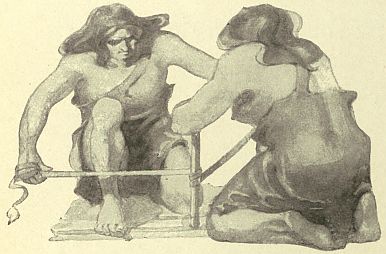
What do we burn in our fires?
How do we light the different fires that we have?
What do we burn for light?
How do we light our lights?
Find out how your grandfather and grandmother used to light their fires.
Find out what they used for lights and how they took care of them.
Do you know how the Eskimo used to get fire?
When the Cave-men had heard Sharpeyes’ story, they went back to their caves.
The fire clan was left alone again.
Strongarm spoke of going to the fire country himself, but it did not seem best to leave the people just then.
Some of the men had already left the cave, and gone to live as the Tree-dwellers lived.
Strongarm was trying to keep the rest of them together.
He feared that he would not be able to do it unless he could get fire.
For several days after that, the Cave-men thought that Strongarm seemed queer.
Wherever he went he carried the drill that he used in boring holes.
Sometimes he carried a bundle of sticks under his arm.
Sometimes he worked with all these things in a corner of the cave.
None of the Cave-men knew what he was doing, but they heard him mumbling to himself.
Once they saw him start up quickly and go away from the cave.
Nobody knew where he went, and nobody knew what he did.
Strongarm was very sad.
His heart was sore for his people, for they were in great distress.
He believed that the fire god dwelt in the wood, and he was trying to persuade him to come out.
He had noticed that the drill became warm by twirling, when he used it for boring holes.
So now he made a drill of hard wood and twirled it on a piece of softer wood.
As he twirled the stick he prayed to the fire god.
He asked him to come and help the Cave-men.
When he went away from the cave that day, he went to find tinder.
When he came back that night, he was very happy; for he had a burning torch in his hand.

Show how Strongarm acted when he was twirling sticks. Draw the picture.
Find some sticks that you can use in making fire. Put them in a place where they will dry.
Look at the pictures on pages 45, 48, and 49. What is the difference between a drill for boring holes and a fire drill?
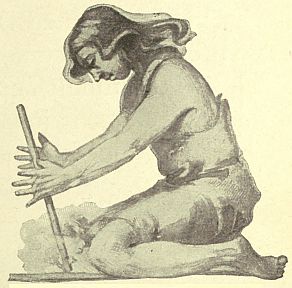
What do you think the Cave-men did when they saw Strongarm coming with fire?
Do you think he told them how he got it?
Did you ever have a secret? What kind of things do you wish to keep secret?
Can you think why Strongarm might wish to keep his discovery a secret?
How glad all the Cave-men were when they saw Strongarm coming with fire!
They ran out to meet him and shouted for joy.
Firekeeper lighted a fire, and the women brought branches to make it blaze.
The wild animals sniffed it and ran away.
The Cave-men joined hands and danced around the fire.
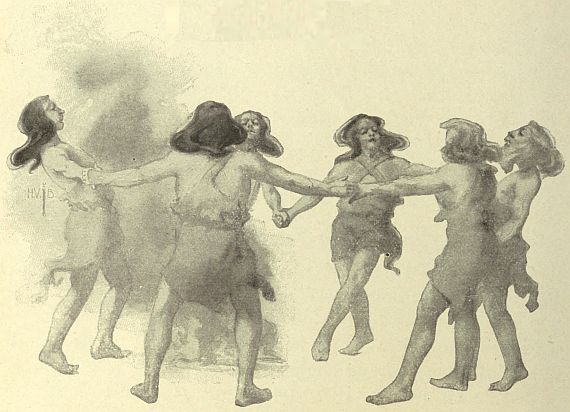
They danced until they could dance no more, and then sat down on the ground to rest.
They asked where Strongarm found the fire, but he did not tell them then.
Some of the Cave-men were very selfish.
They cared more for themselves than they did for the clan.
Some of the men had already left.
Others were thinking of going away.
Strongarm wanted to teach them to help one another.
So he told them only part of the truth.
He said nothing about the fire drill, but he told them about his prayer.
He said that the fire god came when he called him.
At this the Cave-men were filled with fear.
They looked upon Strongarm in wonder.
After that they treated him with great respect.
When they needed a chief, he led them.
He was the greatest man of the time.
Show how the Cave-men rejoiced when Strongarm came with his burning torch. Draw the picture.
Show what you think they did when they were told that the fire god came at Strongarm’s command.
Do you know why we have Thanksgiving Day?
How would the Cave-men show that they were thankful?
How thankful the Cave-men were to have fire again!
They wanted the fire god to know it.
They wanted their neighbors to have fire, too.
So they sent a messenger with a firebrand to invite them to a feast.
As the messenger neared the cave where they dwelt, he heard the people wailing.
He hurried on with the glad tidings.
When the people saw him, they ran to meet him and lighted firebrands of their own.
Their sadness was turned to joy.
They told the messenger that their bravest man had been killed that very day.
He had been carried away by a tiger while standing near the cave.
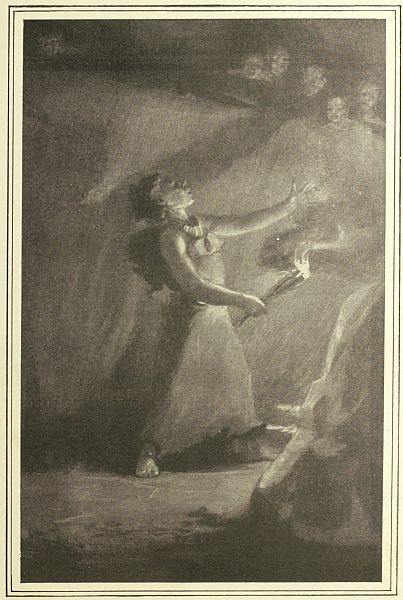
They feared that the tiger would return, and that they all would be killed.
But now that they had fire again, they began to feel more safe.
The messenger told them what Strongarm had done, while they stared with open mouth and eyes.
When the messenger invited them to the feast, they quickly made ready to start.
The feast was ready when they reached the cave.
The Cave-men were filled with joy.
They gathered around the fireplace.
Everybody was silent while Strongarm gave some of the choicest meat as an offering to the fire god.
Then they all began to eat.
They feasted and talked a long time.
They shouted praises to the fire god.
They were thankful to have him with them again.
All the people were happy once more.
Play some game where you all join hands and dance around in a circle. Draw a picture of it.
How many ring games do you know how to play?
Play that you are having a thanksgiving feast.
Did you ever go out in the woods in the spring to find something to eat?
Have you ever tasted the bark of any trees?
If there are any spruce trees near you, find out what they are good for.
All the snow was now gone from the wooded hills.
The people were glad, for they were tired of the long, cold winter.
They were hungry for fresh green leaves and berries.
One day Firekeeper took a torch and started out over the hills to see what she could find to eat.
She found winter-greens with red berries half hidden among the dry oak leaves.
She ate some and gathered a handful; then she passed on over the hills.
The sap of the spruce trees was beginning to flow and had hardened in places upon the trunks.
Firekeeper bit off a lump and chewed it until she made it into gum.
Then she bit off other lumps, and even bit into the inner bark.
She liked the taste of the bark, so she peeled off large pieces and ate them.
Then she gave a shrill call and listened until she heard a call from the cave.
In a moment she called again.
Again the answer came.
But this time the voices were nearer.
Then Firekeeper knew that the women and children were coming.
Soon she heard their calls again, and again she called to them.
This happened several times, each time the voices sounding nearer.
In this way Firekeeper helped the women to find the way to the spot.
She kept watch until they came in sight.
There were women carrying flaming torches, and others with babies strapped to their backs.
Children followed close to their mothers’ heels or ran along beside them.
The cradles were hung on the branches of the trees.
While the women were getting a taste of the bark, Firekeeper was hunting slender twigs for baskets.
All the women soon joined Firekeeper in the work.
They broke off slender branches from the spruce trees and trimmed them and laid them in bundles.
Then they dug spruce roots with sharp digging sticks.
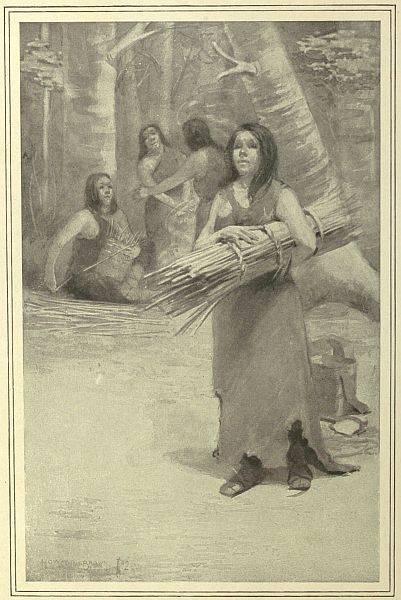
After eating all the bark that they wished, they played with the children among the trees.
The mothers strapped bundles on the little girls’ backs, but took the larger bundles themselves.
They strapped the cradles on top of their loads.
They followed the river path on their way home and stopped when they came to the drinking-place.
After drinking the fresh cool water, they dug shallow holes near the edge of the stream.
They dug little troughs from these holes, so that the water of the river could flow in.
Then they put the spruce branches into these holes and left them there to soak.
When they reached the cave that night they were tired and hungry, too.
But the men soon came with plenty of meat, and soon they were all eating and resting around the open fire.
Go out to some uncultivated spot and see if you can find twigs or branches that can be made into baskets.
See if you can peel the bark from the stems.
Soak some twigs in water and see how much easier they will bend than dry twigs do.
See if you can find hardened sap on a spruce tree. Make it into gum.
Show how Firekeeper and the women called back and forth.
What have you seen that is made of splints of wood?
Find branches that can be made into splints.
See if you can do anything to the wood to make it split more easily.
How many splints do you think the women split the stems into at first? How could they make flat splints?
How could they make splints that were the same width?
After the spruce branches had soaked a few days, the women brought them to the cave.
While the children played with sticks and stones, their mothers made some splints.
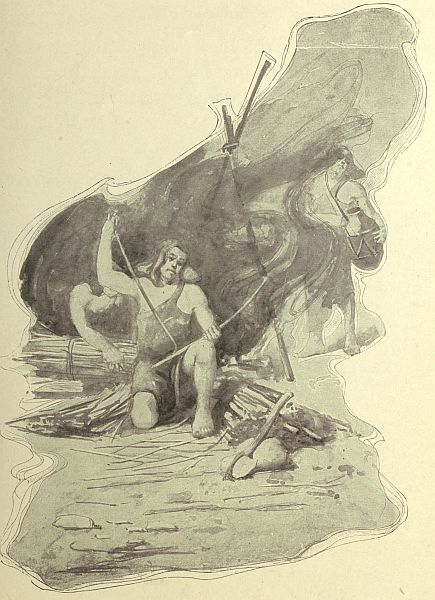
They peeled off the bark with their teeth and nails, and split one end of the stem.
Then they held one piece with their teeth and pulled the other two pieces with their hands.
The splints that they made in this way were neither round nor flat.
They had three sharp corners.
Two of these corners were hard and tough, but one was soft and pithy.
So they bit the pithy corner and pulled off a long strand of pith.
This left a thick splint that was nearly flat.
The women found that it was hard work to split the larger stems.
They were about to give it up when Firekeeper found a large stem whose layers of wood peeled easily.
So they all tried to find such stems.
It was not long before they found that the stems that peeled the most easily were the ones that the children had pounded.
So they all picked up hammer stones and pounded the large stems.
At first each hammered to suit herself, but soon they learned to strike together.
It was easier for them all when they worked in the same time.
People who have made splints for baskets since then have worked in the same time.
Sometimes they keep time by calls and sometimes they use rhymes.
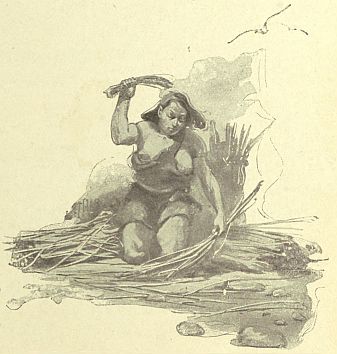
Perhaps you have heard a bark-beater’s rhyme, or have a rhyme yourself.
This rhyme is used by children nowadays when they try to beat in the same time:
“Sip, sap, say; sip, sap, say;
Lig in a nettle bed, while Mayday.”
Gather tough branches of trees or shrubs that you have a right to use.
See if you can make them into splints for baskets.
Find a way of making brittle wood more tough.
Beat the stems with hammer stones so as to loosen the layers of wood.
Keep track of a tree or a shrub in your neighborhood during the year, and find out the best time of the year to gather its branches for baskets.
What do you think would be the easiest way for the women to weave the splints into baskets?
What kind of baskets did they need? Would they be apt to make them all in the same way?
Have you ever seen a basket that will hold water?
If a basket was almost water-tight, how could you make it water-tight?
When the splints were made, the women began to weave them into baskets.
Some of the splints were wide and some of them were narrow.
Some of them were thin, and some of them were thick.
But the women did not mind this.
At first they wove them by interlacing, as Sharptooth had woven the basket of rushes.
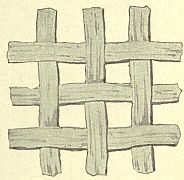
But since the strands were not all the same width, the weaving did not look the same.
After a while they began to sort the splints.
They put the wide splints into one pile and the narrow ones into another.
Then they wove the wide splints in open work and made baskets for carrying roots and leaves.
They wanted smaller baskets for carrying berries, so they used the narrow splints.
They wove these splints in close work so that the berries would not drop out.
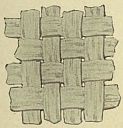
Some of the women wanted still closer weaving, so they pressed the splints down with their fingers.
When their fingers became sore from pressing hard, they used a long bone.
By driving the splints with a long bone, the weaving was made firm and strong.
Some of the baskets they made in this way were found to be water-tight.
So they sometimes used them for carrying water.
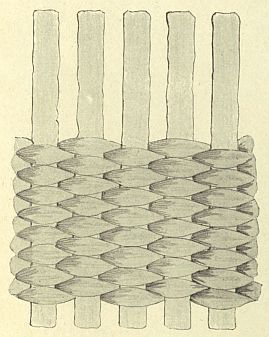
When the baskets became very dry, the wood shrank and this made little holes in the baskets.
But the women soon learned to stop the leak by mending the baskets with pitch.
Find baskets that are woven in open work.
Find baskets that are woven in close work.
See if you can find a water-tight basket.
Draw a picture of the women weaving baskets.
Weave a basket or a mat in close work.
Use a stick and drive the woof strands close together.
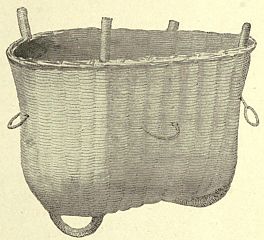
Look at all the uncolored baskets that you have a chance to see and select the basket that you think is the best. Why do you think it is the best? What is it used for? How is it woven?
Look at the baskets that are made of two or more colors and select the one that you think is best. Why do you think it is best? How do you think the colors were made? Can you tell how the pattern is woven in this basket?
Can you think of any colors that the Cave-men could use in their weaving before they learned to color reeds and splints?
Can you think how they might have found a way to stain their baskets? Do you ever get stains in your clothing? What stains will wash out most easily? What stains do not come out easily? Which ones would you like to use to stain a basket? Do we have anything in our houses that we stain on purpose? What do we use to stain with?
Have you ever seen colored earth? Can you think what it is used for? Why do you think the Cave-men liked to find colored earth?
Where do you put water to boil it? Why did the Cave-men learn to roast food before they learned to boil it?
Did you ever see anybody make dyes? Do you think people could make dyes before they learned to boil water?
Can you think of ways in which the Cave-men might have changed the color of grasses, splints, and reeds before they learned how to boil water and to make such dyes as we use to-day? Why do you think they would wish to color them?
The women took a great deal of pains in weaving baskets.
They wove the ends in carefully so they would not pull out.
They bound the rims on neatly, so as to make the baskets strong.
But for a long time they did not try to ornament their baskets.
They wove their baskets so carefully that they were beautiful without ornaments.
At first they wove each woof strand under and over each strand of the warp.
Then they began to weave each woof strand over one and under two.
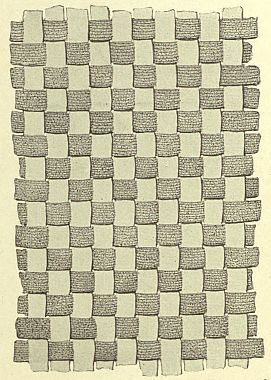
This made such a pretty pattern that they tried other ways of weaving.
They soon learned to use strands of different sizes, and after a while they learned how to color them.
But they could not make such dyes as we have until they learned to boil water.
Sometimes they found bright-colored leaves and feathers and wove them with the splints and reeds.
Sometimes they stained the finished basket with the juices of fruits and berries.
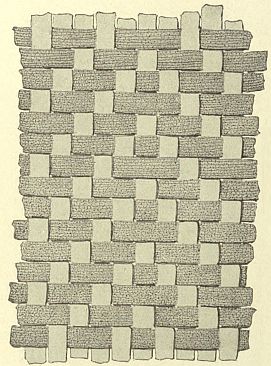
Sometimes they painted patterns on it with paint that they made of colored earth.
Then they learned to dye the splints and reeds in a very simple way.
They soaked them in water before they used them, so as to make them pliable.
They found that willow stems that were soaked in water were colored light brown by the bark of the stem.
Splints buried in the leaf-mold of the brooks and marshes were colored a dark brown.
When charcoal was mixed with the rich leaf-mold the splints were colored black.
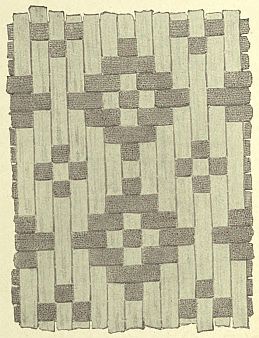
Green grass became white when soaked in water, and yellow if soaked for a longer time.
The women used these and other ways of getting pretty colors.
Then they worked the colors into pretty patterns, many of which we use to-day.
Weave uncolored splints or reeds so as to make different patterns.
Find a fruit that will make a durable stain, and stain some splints for a basket, or make a pattern by staining an uncolored basket.
See if you can find how to take fruit stains out of clothing.
If you can find colored earth, see if you can make some paint to use in ornamenting your baskets.
Try different ways of changing the color of grasses, splints, and reeds, by soaking them in water or burying them in different kinds of soil.
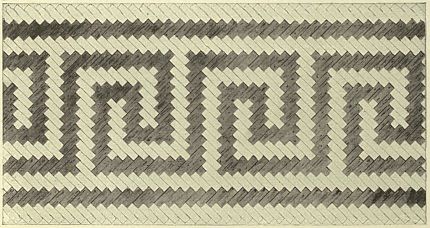
How do you carry the things that you bring to school?
How is the food that you eat brought to you?
How is your clothing carried to you?
Do you know how the material that your house is made of was brought to the spot?
How does the farmer carry oats to his horses? How does he carry milk to the calves? How does he carry hay from the field to the barn? How does he carry hay from the mow to the manger?
What things do you carry in your hands? What do you carry in baskets? What do you carry in trays? What other things do you use in carrying?
How do you think the Cave-men would carry an animal that they had killed to the cave? Do you think they would try to bring the whole carcass home?
What things would they carry in baskets? Why did they need handles for their baskets? Think of as many ways as you can that the Cave-men might have carried things.
The Cave-men used the baskets they made for carrying roots and berries.
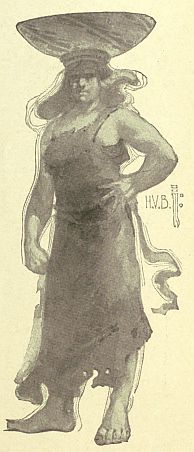
It was easier to carry them in baskets than to carry them in their hands.
But it took one hand to hold the basket, and they often needed to have both hands free.
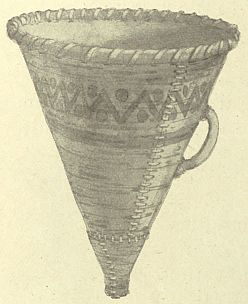
So they learned to carry baskets on their heads and shoulders.
When the Cave-men jumped in time of danger, they were apt to lose their load.
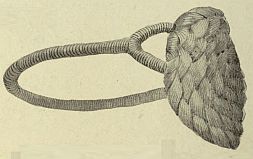
So they learned to make handles for their baskets and to carry them with strong straps.
When they rested the strap upon the forehead, it was a head strap.
When the basket was heavy, the head strap pressed hard against the forehead and cut through the skin.
So they made little pads to protect their foreheads.
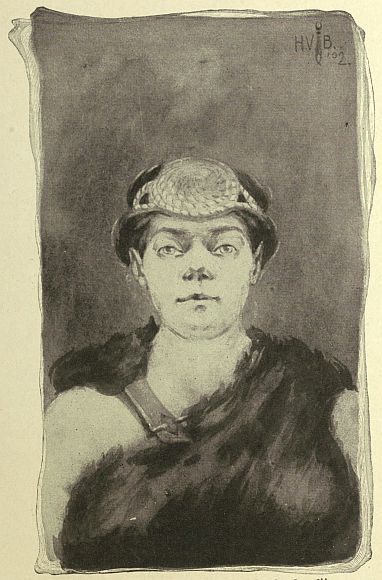
At first these pads were bunches of grass or pieces of soft skin.
But the women soon braided carrying straps that had pads for the forehead.
Sometimes they let the strap rest on the shoulders.
Then it was a shoulder strap.
When they let it rest upon the breast, it was a breast strap.
All the Cave-men learned to use straps so, and many people still carry things in that way.
Play carrying something on the head. The one who can carry the longest without dropping his burden wins the game.
Look at the handles of all the baskets you can find and see if you can tell how they are used. Can you think of any better way of carrying these baskets?
Make a handle for a basket.
Make a carrying strap and show how to use it for a head strap. Show how to use it for a shoulder strap and a breast strap.
Draw a picture of a woman carrying a basket.
Model in clay a Cave-man who is carrying a wild pig on his back.
Why would the Cave-men not be so likely to attack a mammoth as a cave-bear?
Why would they want to kill a mammoth?
Do you think the mammoth would be afraid of the Cave-men’s weapons? What was the mammoth afraid of?
One day Strongarm saw a herd of mammoths grazing near the edge of a cliff.
He had often wished to capture a mammoth, but had never had such a chance before.
He blew his bone whistle.
All who heard it called to others farther away.
Soon all the men from the wooded hills came running to the spot.
They wanted to attack the mammoths, but Strongarm would not let them.
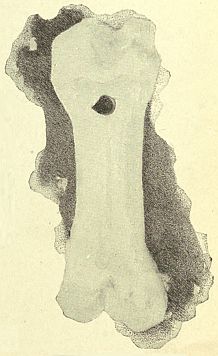
He knew that their weapons were not strong enough, so he showed them what to do.
Then they all hunted for good sticks to make into torches.
When the torches were made, the Cave-men formed a line from one edge of the cliff to the other.
They crept up through the low bushes until they were only a few steps from the herd.
The mammoths did not see the men until Strongarm gave the signal to charge.
Then they started to run.
But the Cave-men chased them, waving their torches in the air.
The Cave-men pressed close after the mammoths until they came to the edge of the cliff.
They filled the air with their loud cries.
When the mammoths saw the trap they were in, they turned and faced the men.
One mammoth was crowded over the edge of the cliff.
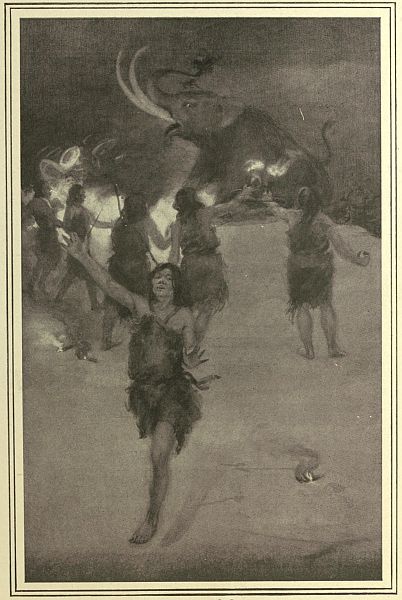
When the Cave-men saw the mammoth fall, they broke the line and let the herd escape.
Then they hurried down by a well-known path to the spot where the mammoth lay.
He had been killed by the fall.
The Cave-men seldom got such a large creature as the mammoth.
Everybody was glad, so Strongarm sent messengers to all the caves to call the women and children to a feast.
Show how the Cave-men hunted the mammoth.
Model a mammoth in clay.
When you go to a museum, inquire if there is a skeleton of a mammoth there.
How do you think the mammoth will be divided?
How will the meat that is left after the feast be carried?
Do you know what kind of a coat the mammoth has?
How long do you think its tusks are?
Can you think how we have learned about this animal that lived such a long time ago?
When the women heard what the men had done, they danced and shouted their praises.
Then they all prepared for the feast.
You know how the Cave-men acted at a feast.
They all ate as much as they could.
Then the older men and women began to tell stories.
All gathered around to hear the stories, and then they joined in a hunting dance.
They feasted and danced for several days.
Even then there was plenty of meat.
There were trophies, too, for the bravest men.
All the Cave-men admired the mammoth’s tusks, and they tried to loosen them with their hammers.
The tusks belonged to Strongarm, but others shared in the meat and the bones.
When the feast was over, Firekeeper divided the meat.
The women loaded it upon their backs, or dragged it on the ground.
They carried the tusks with strong straps which hung down from their shoulders.
The women and children carried the burdens while the men protected them on the way.
All the Cave-men divided their work in this way.
They all knew they were safest when the men were ready to fight.
If the men had carried the burdens, all the people might have been killed.
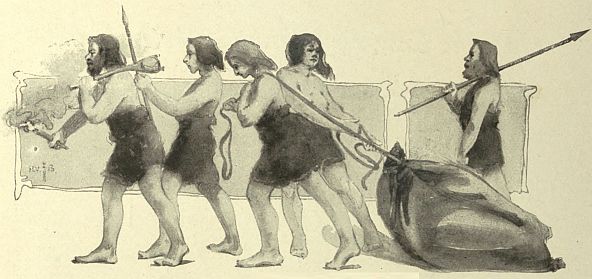
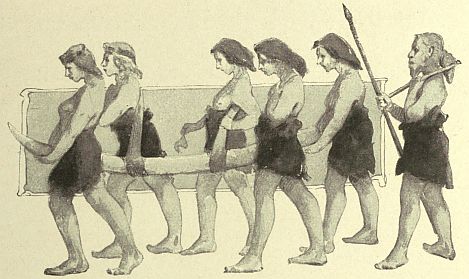
Show how the women and children danced and shouted the praises of the Cave-men. Draw a picture of them.
Name animals that have tusks. What do they use their tusks for?
Show how the long line of Cave-men looked when they were traveling on their way home. Draw a picture of them.
Do you think Strongarm will ever tell any one how he got fire?
Why do you think people used to be so careful of the fire?
Do you know of any people who make fire by twirling sticks?
Do you think that you can make fire by using a fire drill?
Can you think of a name for the wood that is ground up as the spindle of the fire drill is twirled?
Do you ever gather kindling to start a fire? Have you ever seen or heard of tinder?
Several years had passed by since Strongarm made fire.
The Cave-men had never prospered so before.
Strongarm was their wisest man, and they all obeyed him in time of danger.
Cave-men came from far and near to see him and to hear what he said.
He had kept his secret all these years, but now he knew that it was time to tell it.
He knew that he was growing old, and that some one else must share the secret.
So one day he called Firekeeper to a fallen tree that had lain near the cave for many years.
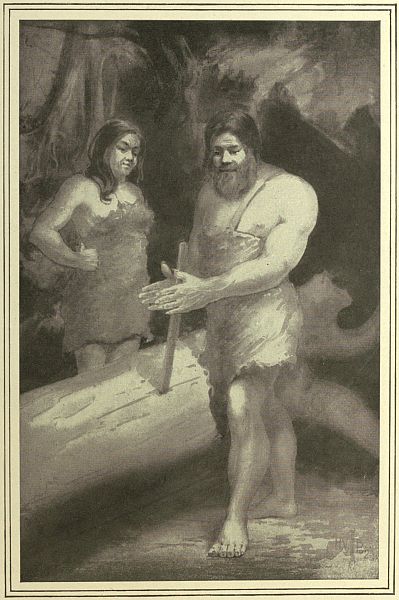
Its wood had become very dry, and parts of it were beginning to decay.
It was by this log that he told his secret.
It was here that he showed Firekeeper how to make fire.
He took a dry stick for a spindle and twirled it on the dry log.
As he twirled he prayed to the fire god.
He worked until he got fire.
Then he let Firekeeper twirl the sticks until she got a spark.
The first time she tried it, she could not get fire.
So Strongarm showed her how to make a groove in the log where the wood meal could collect.
Soon the wood meal began to glow, and she gently fanned it with her hand.
She placed dry tinder close beside it and fanned it into a blaze.
Then Strongarm told her to teach her daughters how to make fire.
He and Firekeeper were growing old, but he knew their clan would always need fire.
Firekeeper remembered what Strongarm said, and she taught her daughters to make fire.
A few years after all the clans on the hills had some one who knew how to make fire.
In some clans a woman did this work.
In others young girls did it.
In some clans this work was done by men.
Everywhere people had some one to make and take care of the fire.
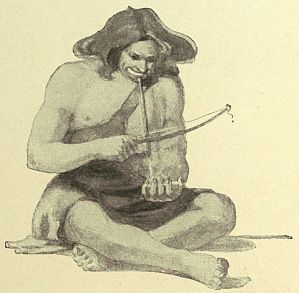
Show how Strongarm taught Firekeeper to make fire.
Examine the sticks that you selected some time ago for a fire drill.
If you choose a hard piece for a spindle, your drill will work better if you choose soft wood for the hearth.
Round the ends of the spindle and make a shallow hole with a groove beside it in the hearth.
Make a shallow hole in a flat piece of wood to hold the upper end of the spindle.
After you learn to work the drill with your hands, try a strap.
When you can use the strap easily, try a bow.
If you keep on trying you will be able to get fire with your fire drill.

Have you ever read stories not written in books?
Can you think how large pieces of rock get broken off from the cliffs?
Can you think how they become smooth and rounded?
How do you think that the pebbles you find along the stream got there?
See if you can track a pebble up the valley of the stream in which you found it.
What does the river take with it as it journeys toward the sea?
What part of its load drops first?
Perhaps you have wondered if these stories are true.
Let us see if we can find out how we got them.
You know that the Cave-men lived long ago.
You know that they could not read or write.
You know that they did not write any stories.
But they told their children the brave deeds of their people.
They told them of combats with wild beasts.
They told them stories about their gods.
Their children told these stories again.
These stories were told a great many times.
Sometimes parts of the stories were left out and other parts put in.
Only part of the Cave-men’s story is left, and it tells only a few things that the Cave-men did.
But there are other ways of learning about them.
We have learned something from the weapons that have been found.
Perhaps you have done something like this yourself.
Perhaps you have found an Indian arrow.
Perhaps you can read what it tells of the Indians.
That will help you to learn more about the Cave-men.
You remember the time that the caves were flooded and the tools and weapons washed away.
They were dropped on the flooded plains and buried in the sands and gravels.
There have been many floods since then, and each time the river has dropped part of its load.
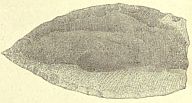
So the weapons have been buried very deep.
Sometimes people have dug deep down into the earth, and sometimes they have found the Cave-men’s weapons.
There are pictures of some of them in this book.
Can you see that they tell what the Cave-men did?
Bones, too, have helped to tell something of the Cave-men.
A great many bones have been found in the caves.
Most of the marrow bones were split.
Animals do not know how to split bones, so we know that they must have been split by men.
These bones have been taken to great museums, where wise men have studied them carefully.
The wise men have learned to read their story.
The bones tell that the Cave-men ate animal food.
They tell what animals lived at that time.
They tell that people were living then, too.
Perhaps you have seen fossil plants in rocks.
Some of them tell what plants were living then.
Many people have studied all these things.
They have tried to read all the stories they tell.
We have tried to learn what they have found and to write it in a story for you.
Can you understand now how these stories are true?
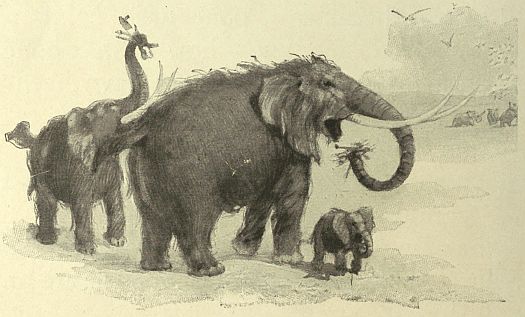
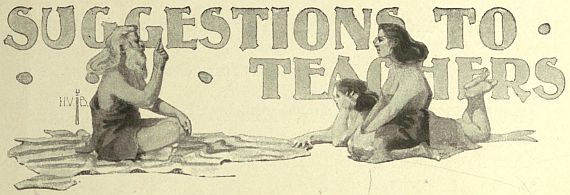
THE best results will come from the use of this book if the teacher will give as careful attention to carrying out the suggestions under “Things to Think About” and “Things to Do” as she does to the study of the book itself. In this way she can help the child make vital relations between the study of nature on the one hand, and man and his works on the other.
References: Teachers and parents who wish to read books written by specialists who have devoted years to the study of the period under consideration, will find the following list of value:
1. Books.
Clodd, Edward, The Story of Primitive Man. New York: D. Appleton & Co.
Dawkins, W. Boyd, Early Man in Britain. New York: The Macmillan Company.
Dawkins, W. Boyd, Cave-Hunting. New York: The Macmillan Company.
Evans, Sir John, Ancient Stone Implements in Great Britain and Ireland. New York: D. Appleton & Co.
Figuier, Guillaume Louis, Primitive Man. New York: D. Appleton & Co.
Geikie, Archibald, Prehistoric Europe. London: Edward Stanford.
Girod et Massénat, Les Stations L’Age du Renne. Paris:[160] Librairie J.-B. Ballière et Fils. (This deals with the later cave-men.)
Gummere, Francis Barton, Germanic Origins. New York: Charles Scribner’s Sons.
Hutchinson, H. N., Prehistoric Man and Beast. New York: D. Appleton & Co.
Hutchinson, H. N., Extinct Monsters. New York: D. Appleton & Co.
Joly, Nicholas, Man Before Metals. New York: D. Appleton & Co.
Lartet and Christy, Reliquiæ Aquitanicæ. London: Williams & Norgate.
Lubbock, Sir John, Prehistoric Times. New York: D. Appleton & Co.
Mason, Otis Tufton, Origins of Invention. New York: Charles Scribner’s Sons.
Nadaillac, Marquis de, Prehistoric Peoples, pp. 79-112, 127-132. New York: Putnam’s Sons.
Smith, Worthington G., Man, the Primeval Savage. London: Edward Stanford.
Starr, Frederick, Some First Steps in Human Progress. Springfield, Ohio: Chautauqua Press, 1901.
Stoddard, James, The Seven Sagas of Prehistoric Man. London: Chatto & Windus.
Taylor, Isaac, Origin of the Aryans. New York: Charles Scribner’s Sons.
Tylor, E. B., Anthropology. New York: D. Appleton & Co.
Waterloo, Stanley, The Story of Ab. New York: Doubleday, Page & Co.
Wilson, Sir Daniel, Prehistoric Man. New York: The Macmillan Company.
Wright, G. F., Man and the Glacial Period. New York: D. Appleton & Co.
Worsæ, J. J. A., Industrial Arts of Denmark. London: Chapman & Hall.
2. Magazine Articles.
Barton, Julien, and Sheppard, W. L., “Eighty Miles in Indiana Caves,” Scribner’s Magazine, Vol. XIX., pp. 875-888.
Broca, Paul, “The Troglodytes or Cave-Dwellers of France,” Popular Science Monthly, Vol. II., pp. 699-708.
Larrabee, W. H., “Cave-Dwellings of Men,” Popular Science Monthly, Vol. XLI., pp. 27-45.
Oswald, Felix L., “Modern Troglodytes,” Popular Science Monthly, Vol. XII., pp. 37-46.
Rau, Charles, “The Stone Age in Europe,” Harper’s Magazine, Vol. L., pp. 681-690.
3. Government Reports.
Broca, Paul, “The Troglodytes or Cave-Dwellers of the Valley of the Vézère,” Smithsonian Report, 1872, pp. 310-347.
“Man as the Contemporary of the Mammoth and the Reindeer in Middle Europe,” translated by C. A. Alexander, for the Smithsonian Institution, from “Aus der Natur: die neuesten Entdeckungen auf dem Gebiete der Naturwissenschaften,” Leipzig, 1867, Smithsonian Report, 1867, pp. 335-362.
Wilson, Thomas, “Anthropology at the Paris Exposition in 1889,” Smithsonian Report, 1890, pp. 641-680.
Classifications. In reading the above books for the purpose of supplementing the first three numbers of this series, it must be remembered that no uniform system of classification has been adopted and that the reader must become familiar with several in order to be able to use the reference books most advantageously. To help the reader in getting a working idea of the different classifications the following summaries may be of value:
The progress of mankind is classified by Professor W. Boyd Dawkins into the following periods:[162]
Others classify the period with reference to the materials used in making implements and weapons and give us the following:
Still others classify with reference to the dominant industry of the period, giving:
The Pleistocene period is the one that is treated in the first three volumes of this series. It is the period that is frequently designated as the Paleolithic or Rough Stone Age in contrast to the Neolithic or Polished Stone Age which belongs to what Professor Dawkins calls the Prehistoric Period.
Professor Dawkins divides that part of the Pleistocene period during which man inhabited the earth as the mid-Pleistocene and[163] the late Pleistocene periods. Monsieur Du Pont, dividing it with respect to the form of animal life most characteristic, gives us the Age of the Mammoth and the Age of the Reindeer. M. de Mortillet, classifying it with reference to the localities which have yielded most materials for study, has made current the terms the Chellian, the Mousterian, the Solutian, and the Madelenian epochs. The following table may serve to indicate in a general way how these various classifications are related. The reader who would like to pursue the question of classification further will find good summaries in the Smithsonian Report of the U. S. National Museum, 1888, p. 604; in the Smithsonian Report of the U. S. National Museum, 1890, p. 649; in Morgan’s Ancient Society, pp. 3-29, and in Dawkins’ British Pleistocene Mammalia.
The Tree-dwellers. |
The Early Cave-men. |
The Later Cave-men. |
The Age of Fear. |
The Age of Combat. |
The Age of the Chase. |
The Age of the Mammoth. |
The Age of the Reindeer. |
|
Period of Extinct Animals. |
Period of Migrated Animals. |
|
Dawn of the Rough Stone Age. |
The Paleolithic or Rough Stone Age. |
|
Eolithic Epoch. |
Chellian Epoch. |
Mousterian Epoch. Solutian Epoch. Madelenian Epoch. |
Mid-Pleistocene Period. |
Late Pleistocene Period. |
|
The Pleistocene Period. |
||
Climate mild and equable. |
Climate becomes much colder. Great extremes of heat and cold. |
Arctic climate. Cold and dry. |
Animals that have since become extinct.
The Irish deer, the big-nosed rhinoceros, the mammoth, the straight-tusked elephant, the cave-bear, and the sabre-toothed felis were survivals of an earlier period and were accustomed to a warm climate.
The small-nosed rhinoceros came from the south and the woolly rhinoceros came down from the north during this period.
At the close of this period the big-nosed rhinoceros and the sabre-toothed felis became extinct. |
The same as in the preceding period with the exception of the big-nosed rhinoceros and the sabre-toothed felis, which were extinct. All of the animals named became extinct at the close of this period. |
Animals that have since migrated.
The musk-sheep and the marmot came down from the north during this period, stayed through the next period and then migrated to the Arctic regions. |
General invasion of Arctic animals.
At the close of the period they migrated to the north. |
Living species.
In addition to those that migrated there were the lion, panther or leopard, lynx, wild-cat, spotted hyena, hippopotamus, brown bear, grizzly bear, wolf, fox, stag, roe, urus (the original form of the wild cattle), aurochs or European bison, horse, wild boar, beaver, and water rat. Many of these animals migrated south in the winter and returned each spring. |
The same except that those animals that could not stand the intense cold, migrated south each winter.
Arctic fauna characteristic of this period. |
Field Trips. In localities where the natural materials needed for the child’s work are near at hand it will be best to gather them immediately before they are to be used. In regions less favorably situated it will undoubtedly be best to plan the work so as to make a few trips serve the purpose. Perhaps the trips most needed to make the lessons of this book yield their full value are the following:
1. To a stream of water to notice:
(a) The wearing and building power of the stream.
(b) The location and the strength of the current.
(c) The best places for fords and for bridges.
(d) The tributary streams and springs.
(e) The location of ravines in relation to the river.
(f) Caves or places where caves may have been or may yet be formed.
(g) The nature of the soil and its adaptation to the formation of caves.
(h) The parts of the neighboring land that would be flooded first if the river overflowed its banks.
(i) The place in the river where a natural dam might be formed.
(j) The place where an artificial dam might be built.
(k) Sites that would make good camping-places for hunters.
(l) Places where the best stones for weapons can be found.
2. To uncultivated spots on hillsides, in the woods or meadows to find:
(a) Tough sticks and branches that are so shaped that they can be fastened firmly to stone implements.
(b) Tough and flexible branches for making baskets.
(c) Tough grasses for making mats, baskets, and sandals.
(d) Birch bark for making baskets, picture frames, etc.
(e) Natural gum and pitch.
(f) Wood that is suitable for making a fire drill.
(g) Tinder and punk for making fire.
(h) A bed of gravel where good stones can be found.
(i) Animals and plants that may be of interest to the child.
Field lessons should be supplemented by informal trips by different members of the class. A view from the window of a high building may serve to give the child the relative location of[166] the different parts of a river valley. Such a view is of special value after a trip, for it gives a unified view of the whole.
In places where access to natural materials is exceedingly difficult, it is well to secure the advantages that come from a system of exchange. The American Bureau of Geography offers opportunities for securing all kinds of raw materials as well as specimens showing “the changes incident to their conversion into finished products.” Teachers who wish to avail themselves of the privileges of this bureau can secure a circular containing full information regarding it by sending a letter with an enclosed stamp to the director of the bureau, Winona, Minnesota.
Lesson I. The inexperienced child may think of a cave as a dark, damp place, fit only for the habitation of wild animals. The cave as a habitation for man is a new idea and cannot be understood unless it is related to the natural and social conditions which prevailed during the earliest stages of culture. The child who has read The Tree-Dwellers knows that before people learned to use fire, the caves were inhabited by the cave-bear, the cave-lion, the sabre-toothed felis, and by packs of spotted hyenas. He is prepared to understand why people were glad to live in caves. To help the child who has not had such a preparation understand this fact, ask him to think of a time when people had no shelter except the trees, no clothing except the skins of wild animals, no food except wild roots, fruits, and nuts, and no fire. After he has considered man’s life under such conditions, tell him of the conquest of fire, and of the changes effected in social life by its use. Help him to see that fire was man’s best means of protection at that time, for it was greatly feared by wild animals. By means of a free conversation about the points that the child may have difficulty in understanding, he will get a conception of man’s life before he lived in[167] caves, and this is the best basis for understanding why people wanted a cave for a home.
If the child is not familiar with wooded hills, grassy plains, and dense forests, make use of field trips, of views from windows in high buildings, and of pictures to get a conception of them, and provide an opportunity for him to express his idea by modeling in sand. (See The Tree-Dwellers, pp. 18-27.)
Encourage the child to invent ways of getting a cave from a wild animal, but hold him responsible for the use of only such means as the cave-men had. The child who would use a gun, or even a bow and arrow, must learn that these devices were not yet invented, and that man had to use his mind to devise some way of conquering the wild beasts without the aid of such weapons.
References: Katharine E. Dopp, The Place of Industries in Elementary Education, pp. 16-25. Chicago: The University of Chicago Press, 1903. The Tree-Dwellers, pp. 89-101, 149, 150. Chicago: Rand, McNally & Co., 1903.
Lesson II. Although the main point of interest in this lesson is the way the fire clan takes possession of the cave, this social interest may be used as a means of learning various facts regarding the changes that take place in the natural world during late autumn. When such phenomena are seen as forces affecting the activities of man and of animals, they become interesting to the child. But if isolated from all social interests, if learned at all, they are carried as a dead weight. Encourage the child to act out the simple movements depicted in the story. At first this may be done during hours of play, but as teacher and children become accustomed to it, it should become a regular feature of the school work.
Lesson III. Knowing that Sabre-tooth is waiting for a chance to get into the cave, the child can understand why the first evening at the cave will be spent in planning ways of getting rid of him.
Perhaps the child may not realize at first why the cave-men[168] were so careful to keep the fire burning, but if the use that they made of fire is emphasized, gradually he will appreciate something of what its loss might mean to the cave-men.
Lesson IV. Use this lesson to help the child get the meaning of the contrast between the crude implements that the cave-men used in securing food and in protecting themselves from their enemies, and the devices that we use for a similar purpose. In spite of the great contrasts that will be discovered, the child will find points of likeness between the implements of the cave-men, rude counterparts of which he can fashion for himself, and those that are still in use. Focus his attention upon the needs of the people that called forth the mechanical inventions of the period, and the use to which they were put in making the earth a safer place in which to live. By so doing, the killing of wild beasts, which, when considered as an end in itself, arrests the development of the finer feelings by fixing attention upon suffering without any purpose, becomes transformed into an act of great social significance; for we must not forget that the cave-men, by exterminating the most dangerous of the wild beasts, made the earth a more fit dwelling place for all succeeding ages. If the child, at this early period, can learn that the hunting peoples killed only enough to supply themselves with food and skins for clothing, and that even beasts of prey rarely kill more than they need for food, they will be in a position to treat many problems in a more rational way than they are usually treated.
The modeling of Sabre-tooth in clay is suggested for the sake of cultivating the habit of observing the beauty of form and movement in animals, and turning the interest that may have been generated by the lesson into artistic channels.
Lesson V. No doubt the flesh of the sabre-toothed felis was not an attractive food, but in early times nearly everything was tested for food and used unless it was found to be injurious. Even[169] though the cave-men had plenty of food, they no doubt would enjoy feasting upon the flesh of their enemy. Perhaps they believed that through eating Sabre-tooth’s flesh they might acquire something of his strength and courage.
The first cooking was undoubtedly the result of an accident. The invention was made only when man consciously controlled the process. At first, no doubt, animals were roasted in their skins, but as people began to prize skins for trophies, for clothing, and for thongs, they formed the habit of removing the skin. The fear that Sabre-tooth inspired would insure the removal of his skin for a trophy. The same is true of the sabre teeth.
Strongarm’s leadership illustrates the natural leadership of the most fit in time of danger. At other times, without doubt, there was no recognized leader.
References: Katharine E. Dopp, The Place of Industries in Elementary Education, pp. 22-27. Chicago: The University of Chicago Press. The Tree-Dwellers, pp. 115, 119-121, 156, 157. Chicago: Rand, McNally & Co.
Lesson VI. The manners of the cave-men at the feast may be understood when it is remembered that the food supply of hunting peoples is irregular. Their lack of forethought is such that there is either a feast or a famine. Besides, their digestive systems were so well developed that it was possible for them to eat enormous quantities without harm. The habit of eating together developed slowly and probably depended largely upon the degree to which coöperative action was used in hunting. Except upon extraordinary occasions we may conclude that only those ate together who worked together in securing food.
Encourage the child to make a collection of as many things as he can find that he can use for or make into dishes.
If the child is allowed to crack the marrow bones of a chicken or turkey and make soup of them, he will understand the liking[170] of the cave-men for marrow bones. The conversion of bones into musical instruments played by striking, or into bone whistles, may also furnish a delightful occupation which may yield results of no mean value.
Lesson VII. Let the children dig cooking-pits and caves of various sorts in the ground and experiment with them to discover where the smoke goes and why, and the effect of the form of the cave or cooking-pit upon the draft. The invention of a means of carrying off the smoke, and the attempt to regulate the draft in these crude contrivances, will lead to an interest in the fireplaces and chimneys in the child’s own house. Make use of this interest in such a way as to lead the child to observe the materials used and forms adopted in the construction of modern fireplaces and chimneys, and encourage him to seek reasons for the same.
Show the child a picture of the interior of a cave that has stalagmites and stalactites, and illustrate their formation by dissolving rock salt or lime in water and letting it drip until a deposit is made.
Lesson VIII. If the cave-men wanted to keep such trophies as teeth and claws of animals, it is evident that they would have to bore holes through them. To pierce bright and shining natural forms, fossil shells, etc., for beads, was an easy matter. To bore holes through such hard objects as the teeth and claws of wild animals taxed the cave-man’s ingenuity. The different devices for drilling represented in this lesson doubtless required ages for their development. It has seemed best, however, to represent them together, since they are all sufficiently simple for the child to understand. The advantage of the use of the strap or the bow in turning the drill will be appreciated by the child after trying to twirl it by the use of the hands alone. To get the best results from this work it should be carried on by the child for several days. He will probably enjoy doing such work outside of school hours. Horizontal drilling upon the thigh, and vertical drilling with or[171] without the strap or the bow, may be carried on in actual boring or as mere games. Such exercises serve to give an insight into related industrial processes of the present, and to establish physical coördinations which can be turned to account in a variety of ways. Let the child try to bore a hole through a hard substance by using a soft spindle with sand and water. Such a device works better than the flint point without the sand. Although much of the experimentation with awls and drills may be made outside of school hours, the results of these experiments should be discussed during the recitation period. In this way the interest that the child takes in play is transferred to his school work.
References: J. D. McGuire, “A Study of Primitive Methods of Drilling,” Smithsonian Report, 1894, pp. 623-756. 201 figs.
Katharine E. Dopp, The Place of Industries in Elementary Education, pp. 27, 133. Chicago: The University of Chicago Press.
Lesson IX. Encourage the child to make a collection of the natural objects in his vicinity that can be used for tools or weapons, and encourage him to make such changes in the natural forms he has collected as he thinks would make them better fitted for the use to which he wishes to put them. Help him arrange them in some part of the schoolroom where they can be referred to easily from time to time. If the child can visit a museum where primitive implements and weapons are exhibited, it will be easier for him to understand the function that such crude implements have fulfilled in the life of the race. Where a museum is not available, the text, together with its illustrations, will supply sufficient data for the child to get an appreciation of the social significance of such implements. But in no case should the observation of the implement or the story about its use be made to take the place of actually making it.
The child will soon learn where to look for the best stones for implements and weapons, and how to choose forms that the river[172] has worn into shapes that require but little work to fit them for use. It is worth while for the child to chip off a few flakes from the stones he selects, for the sake of the practical acquaintance that he gets with the properties of stones.
The name of the stone is a secondary matter, but if the teacher knows the names or can learn them from some person in the community, she can readily make the child familiar with the names of the more common varieties of stones.
In selecting suitable sticks for handles, the child will soon learn that he can save work by choosing a straight branch, and that it is worth while to cut it so as to have a forked end, or a shoulder to which he can bind the weapon. The need of a strong, tough handle furnishes a motive for studying the properties of wood. In rejecting the soft and brittle varieties, the child becomes acquainted with these as well as with the kinds that serve his purpose.
The selection of suitable material for binding the working part to the handle is a matter of considerable difficulty. No doubt the child who uses cord will find it impossible to bind the parts together as firmly as he desires. If after trying different materials no one thinks of the use of a material that will shrink, tell the children of the use of rawhide, and get enough from the meat market to illustrate its use. As the child tries different ways of winding the lashing, he will undoubtedly discover that the most effective binding is secured when the straps are wound symmetrically.
References: Otis Tufton Mason, Origins of Invention, Stone-Working, pp. 121-154. New York: Charles Scribner’s Sons.
Katharine E. Dopp, The Place of Industries in Elementary Education, pp. 20-29, 64, 65, 82, 93, 134-138. Chicago: The University of Chicago Press.
Lesson XI. This lesson illustrates the fact that skins of animals which originally were worn as trophies for the sake of social approval, developed into clothing which was worn partly for comfort.
Let the child make bone awls of the wing bones of chickens, and sinew thread from the sinews attached to the leg bones. Encourage him to sew with these materials. Different ways of lacing the shoes will suggest typical stitches. Others may be found in museums, but the stitches which are a result of the child’s ingenuity will be of most value to him. Later when he discovers that the stitches that he invented were invented ages ago and have been used ever since, he will feel a relationship with people removed from him in time and space. Making sandals or bags for himself or his friends, dressing dolls to play with or to give away, and many other similar activities will also serve to enlarge his interests.
References: Katharine E. Dopp, The Place of Industries in Elementary Education, pp. 22, 25, 115, 116. The Tree-Dwellers, pp. 122-124, 157. Frederick Starr, American Indians, pp. 14-21. Boston: D. C. Heath & Co. “Dress and Adornment,” Popular Science Monthly, Vol. XXXIX., pp. 488-502; also pp. 787-801. Otis Tufton Mason, Origins of Invention, pp. 41, 42, 43, 241. New York: Charles Scribner’s Sons.
Lesson XII. Perhaps we shall never know with certainty what stage the early cave-men had attained in the development of the family. For the purposes of this book however, it has seemed legitimate to supply the deficiency from what is known of the laws of social development. Enough will be accomplished in this subject if the child gets the idea that the family has not always been what it is to-day, and that the need of coöperation in hunting, in guarding the fire, and in protecting the clan from the raids of wild beasts, compelled people who would prosper to associate in this way.
References: Morgan, Ancient Society, pp. 383-508.
Katharine E. Dopp, The Tree-Dwellers, pp. 28-30, 99-101, 150, 156.
Lesson XIII. Since the winter life of the cave-men is depicted much more fully in the following number of the series, it has seemed[174] best to pass it briefly at this time. If the child is encouraged to tell stories of what he thinks happened during the winter, enough will be accomplished in this subject. By writing the story as the child tells it, and allowing him to make corrections in it as it is read to him, he is able to produce a much better story than when he is obliged to write it. As he gets control of his hands, however, he may be asked to write short stories.
Lesson XIV. Undoubtedly the child who lives near birch trees is acquainted with them, for the birch is a tree that offers many attractions to the child. This lesson should extend and enrich these experiences by relating them to the serious activities of people in early stages of culture.
Where the child has the opportunity to see birch trees, but is denied the privilege of removing the bark, help him to see why it is necessary to take that privilege from him and, if possible, provide him with birch bark that can be purchased from dealers in such materials.
Even though birch trees are plentiful enough to permit the removal of the bark by the child, he should be taught to do it carefully and to take only what he needs to use. The same habit should be cultivated with reference to plants of all kinds. In this way the exercise of blind instinct, which in our present environment results in destructive habits, may be so directed as to form a social habit of wise economy in the use of natural resources.
A visit to a museum will suggest many uses for birch bark. Where such a visit is impracticable, well-selected pictures may serve the same purpose.
Instead of furnishing the child with a pattern of a basket, let him make one, first, by the use of paper and, later, with the birch bark. Encourage him to make such corrections as need to be made in the pattern before cutting the bark.
Where birch trees do not grow, it will be best to substitute for[175] the study of the birch a study of some other tree whose bark or branches yield materials for basketry. In prairie regions a study of native grasses may precede this lesson, which may be read and appreciated to some extent, though not in the way it will be where the child is familiar with the birch tree.
References: Longfellow, Hiawatha. Lowell, The Birch Tree. Katharine E. Dopp, The Place of Industries in Elementary Education, pp. 64-67, 121-127. The Tree-Dwellers, Basketry, pp. 138-139. (See articles in encyclopedias and natural histories on the birch.)
Lesson XV. If you have never seen a river in the time of a flood, prepare for this lesson by talking with some one who has, by studying rivers and floods, and pictures of the same, and by making use of experiences that may be gained everywhere during and after a heavy rain. Model the upper part of a river valley, showing the river with its tributary streams and ravines. Show the high rocky banks where the river is narrow and the low banks where the stream is wider. Determine at what place in the river a dam would be apt to be formed during the melting of the snow in the springtime, and what parts of the valley would be flooded first. Then get a clear idea of the way that the flood that is referred to in this lesson took place by modeling an underground channel that connects with the river on the one hand and with the outer world on the other. Such an underground channel, when dry, is a cave of the type that is referred to in this book. Nearly all of the bone caves in England where the remains of the cave-men have been found are of this type. The ravines that are found in limestone regions are regarded by Mr. Boyd Dawkins, who has made a special study of the subject, as caves that have lost their roofs, and the valleys as ravines whose sides have become worn by the process of weathering.
By the use of concrete methods you can help the child to understand these facts very well. He can understand, too, that “the dark narrow passage” referred to in the lesson was a narrow part[176] of the underground channel that led to the river, and that when the water in the river rose to the level of this passage, water would begin to pour into the cave. (See Field Lessons, p. 165.)
Lesson XVI. This lesson shows the cave-man’s need of fire, and the need of coöperative effort in withstanding the devastation produced by the flood.
Lesson XVII. The council undoubtedly originated in a common need and was devoted to devising ways of meeting that need. In the council portrayed in this lesson, the old man, because of his experience and wisdom, gains the ear of the people, and for the time is their leader. In the time of combat with a wild beast, however, Strongarm leads.
Treat the subject of this lesson in such a way as to enable the child to sympathize with the cave-men in their distress, and, in a dramatic way, to unite with them in overcoming their difficulties. In playing the council, let the children decide who shall take the most important parts, and let each test his fitness for taking the part by showing what he can do. Perhaps the best results will come from this if the children hold the council during hours of play.
Most children who are old enough to go to school know something of volcanic fires and fires that are caused by lightning. They know the use of oil in lamps and from this can be led to consider natural oil wells. The old man has heard of the fire country, and it is natural that he should look to that country for the much needed fire. This use of what Nature provides before learning to invent artificial processes is typical of man’s method of advance.
Lesson XVIII. Give the child an appreciation of the difficulties to be met on the journey to the fire country. Use the map to determine the relative location of the fire clan’s cave and the fire country, and let the child show what difficulties he thinks the men will meet with and where they will meet with them by modeling the place mentioned in the sand box. When the main features are thus[177] mapped out, let the children indicate the easiest route, the location of trails, the mountain passes, and the places where the most dangerous wild animals would be apt to be. Point out the mountains that prevent the moisture of the wooded hills from passing over to the dry, rocky country.
When the difficulties of the way are well in mind the children may hold a council to decide what to do to help the men get ready for the journey. After deciding what is needed let them make the articles and dramatize such parts of the life at the cave as they may choose to do. (See map, the frontispiece.)
Lesson XIX. The reference to Sharptooth and Bodo made in this lesson will be understood by the child who has read The Tree-Dwellers. The explanations given under Lesson I. will be sufficient for the child who has not read the book.
It is probable that the sequence of utensils for carrying water differs with the locality. It is likely that the cave-men made use of the cleansed stomachs of large animals they had slain for carrying water before they invented the skin water bag. It was not thought necessary to include that at this time, for the purpose is not so much to develop a complete sequence as it is to present a vivid picture of the way people made use of the natural resources at hand in supplying their needs. The child will derive much pleasure and profit from a careful study of the natural forms in his environment which he can use for carrying water.
References: Katharine E. Dopp, The Place of Industries in Elementary Education, pp. 123-124. The Tree-Dwellers, pp. 43-46, 89-101. Otis Tufton Mason, Origins of Invention, p. 157. Smithsonian Report, 1894, p. 429.
Lesson XX. As long as the cave-men had fire they had no need of a door to the cave. Never having seen doors, it is not strange that the idea of making one did not come until it was forced upon them. When the cave was not protected by a fire or by a[178] wicker-work door, man had constantly to dispute his possession with the wild beasts.
Lesson XXI. Although this lesson affords the opportunity to review the subject of natural fires, the main interest centers in the dramatic action. The contrast between the appearance of Sharpeyes now and when he set out on the journey will serve to emphasize the difficulties encountered. There is an opportunity here for a pantomimic representation of the return of Sharpeyes.
Lessons XXII. and XXIII. These lessons serve to satisfy the child regarding the details of the journey which they have been forecasting for several days. (See Lesson XVIII., p. 87.)
If the child does not know what punk is, tell him that it is decayed wood which, when lighted, holds fire for a long time without making a blaze. For that reason it was much valued as a means of preserving fire, and for tinder. Help the child to find punk in natural woods or along the shores of a lake or stream.
Lesson XXV. If the cave-men had not succeeded in getting fire, their social organization in the form of a clan would have broken up. Strongarm, realizing this and the immense advantage of living in clans, exerted himself to the utmost to get fire—the only means that he knew of for maintaining community life. The fact that he withheld part of the knowledge of the way he secured it is typical of the methods adopted by leaders from time immemorial of gaining ascendency over the masses. It is not the purpose at this time to condemn or to justify the act. That it resulted in securing peace and order within the clan is the point to be emphasized.
It is not known whether the cave-men invented the method of making fire by drilling before that of striking iron pyrites with flint. It is probable that both methods were invented at about the same time, the former in connection with the use of drills for boring, and the latter in connection with the manufacture of stone implements.
Since the sticks for making an effective fire drill should be chosen with care and dried thoroughly, the child should select them at this time, although he may not use them until he studies Lesson XXXIV.
Lesson XXVI. The thanksgiving of the cave-men may well be used to give new meaning to our own thanksgiving festivals. The practice of giving food to the fire arose from the belief that it was alive. This belief and the worship of the fire is readily understood when it is remembered that fire was man’s greatest blessing at this time.
Lesson XXVII. If there are spruce trees in the vicinity, carry out the suggestions given in this lesson. If not, select some other tree or shrub that has tough flexible branches and make use of that instead. Encourage the child to make a basket of branches whose bark has not been removed, and then to peel enough twigs for a basket, using his teeth, finger nails, or other natural tools in doing the work. Be sure that he notices the difference in flexibility between dry twigs and those that have been soaked in water.
Lesson XXVIII. Let the child make such splints as he can without the aid of tools, or with such tools as he invents without suggestions from any person. Notice the rhythmical devices that are used by children when engaged in any kind of work.
Lesson XXIX. If the child has made splints and has already tried to weave them into baskets, he will readily see that the women got a variety in their weaving through the use of splints of different width. He may find it to his advantage to sort his splints, putting those of the same width together. The relation of the different styles of weaving to the need which caused them to be invented should be emphasized. Economy of time and material led primitive people to use the open style of interlacing for baskets intended for carrying coarse materials. The close work was better adapted for baskets used in carrying berries. The impacted work was used[180] for baskets for carrying or for holding water. The child should be encouraged to use such a mode of weaving as is best adapted to the use to which he wishes to put the basket. The making of a water-tight basket involves more skill than the child has attained. He can understand, however, how such a basket was made, and the importance of the invention.
Lesson XXX. There are enough suggestions in this lesson to occupy the child for several days. Encourage him to experiment in natural methods of dyeing straw, grasses, reeds, and splints, by burying them in mud or in mud mixed with charcoal, by soaking them and exposing them to the warm sunshine, or by covering them in leaf mold. Let him test the natural materials in his environment that will yield color and invent ways of extracting it. If red chalk, ochre, hematite, or other mineral matter that may be used as a paint is found in its native state in the vicinity, let the child procure a small quantity and grind it to a fine powder. When mixed with water or with a fatty substance, it is ready to be used. The child may use it in decorating basketry, pottery, or some article that he may wish to have in his playhouse. If the child can see the paintings of primitive people, or illustrations of the same, it will serve to stimulate him to express his own ideas.
References: Report of the Bureau of Ethnology, 1884-5, pp. 216-217. Alice Morse Earle, Child Life in Colonial Days, p. 398. New York: The Macmillan Company. Otis Tufton Mason, Origins of Invention, pp. 226, 255. New York: Charles Scribner’s Sons.
Lesson XXXI. Most of the primitive methods of carrying have survived to the present day and may be seen if one will take the trouble to look for them. The cave-men carried the smaller animals that they killed on their backs. The larger ones were too heavy to be carried in this way, and so the custom arose of dividing the carcass. The most desirable portions were cut out and carried home, while the remainder was left for the wolves and hyenas.[181] Encourage the child to make a carrying strap that he can use in carrying his books or other objects.
References: Otis Tufton Mason, Origins of Invention, pp. 325-48. “Primitive Travel and Transportation,” Smithsonian Report, 1894, pp. 237-593.
Lesson XXXII. Until man had gained a mastery of the more dangerous animals, it is not likely that he hunted the mammoth. The cave-man must have longed, however, to capture one of these powerful beasts, and it is very probable that he would be quick to take advantage of a situation that offered him the opportunity for so doing. This lesson portrays such a situation.
The use of the bone whistle referred to is typical of the first use of musical instruments. The origin of the bone whistle was doubtless associated with the habit of sucking bones. Let the child experiment with whistles so as to discover ways of producing tones of different pitch.
Lesson XXXIII. The capture of such a large animal as the mammoth was the occasion for calling all of the people who were represented in the capture of it to the spot for a feast. The tusks at this time were prized as trophies; later they were used in the manufacture of tools and weapons. The examination of a mammoth’s skeleton will convince one that the tusks were not removed without many hard blows. An idea of the size of the head may be gained from the fact that a single tooth weighed seventeen pounds. This fact will mean little to the child until he tries to lift an object of nearly that weight.
The skin of the mammoth was so heavy that ten men could carry it with difficulty. It was a dark gray color, covered with three coats. The inner coat was a soft reddish wool about five inches long, which protected it from the cold. The second coat was a close-set, tolerably fine, fawn-colored hair. The third or outermost coat was long, black, bristle-like hair which protected[182] it from sharp branches of trees and from heavy blows. This long coarse hair gave the mammoth a more formidable aspect than he otherwise would have had.
References: Katharine E. Dopp, The Tree-Dwellers, pp. 143-144. Chicago: Rand, McNally & Co.
Lesson XXXIV. While the child is studying the habits of the cave-men in respect to the use of fire, train him to be careful in the use of it.
After making a fire drill the child may try to make fire with it, but he should not be discouraged if he fails at first. The process is a difficult one and it requires great care. An old fire drill works best because the wood becomes charred and it is easier to keep a charred drill dry. In working any drill, care must be taken to keep up a steady and rapid motion with a downward pressure. The wood meal which is ground from the hearth by the drill must be allowed to collect in a little heap near which dry tinder is placed. It must be protected from strong drafts, but it may be fanned gently with the hand. As the spindle becomes warm from twirling, the wood meal becomes warm, then it begins to smoke, and at last it is fanned into a flame.
The illustration on page 183 is a reproduction from a photograph taken in 1899 of two third-grade boys of the State Normal School, Oshkosh, Wisconsin, who are using a fire drill. The class succeeded in getting fire with this drill which was made by one of the boys.
References: Walter Hough, “Fire-Making Apparatus in the U. S. National Museum,” Smithsonian Report, 1888, pp. 531-587. “The Methods of Fire-Making,” Smithsonian Report, 1890, pp. 395-409. Otis Tufton Mason, Origins of Invention, pp. 84-120. Scribner.
Lesson XXXV. Since the invention of the printing-press and the dissemination of printed matter, there has been a tendency to[183] overrate the importance of the printed page, and to ignore other more fundamental sources of knowledge. The purpose of this lesson is partly to call attention to other ways of learning than by means of books, and partly to tell the child frankly what the sources are which have been drawn upon for the stories that are written in this book. To be sure he will not comprehend all that is meant by it, but the difference between what he can understand and what the adult understands is not so great as is often imagined. If fossil plants and animals are available, show them to the child and tell him what you know or can find out about them. If the child leaves the book with many unsettled problems, his condition is much more hopeful than if he thinks he has mastered the entire book.
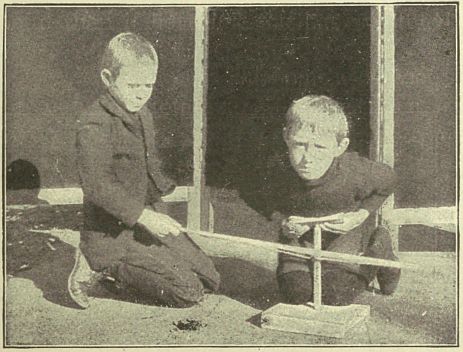
By KATHARINE ELIZABETH DOPP, Ph. D.
Lecturer in Education in the Extension Division of the University of Chicago. Author of
“The Place of Industries in Elementary Education.”
THIS volume makes clear to the child how people lived before they had fire, how and why they conquered it, and the changes wrought in society by its use. The simple activities of gathering food, of weaving, building, taming fire, making use of stones for tools and weapons, wearing trophies, and securing coöperative action by means of rhythmic dances, are here shown to be the simple forms of processes which still minister to our daily needs.
In this volume the child is helped to realize that it is necessary not only to know how to use fire, but to know how to make it. Protection from the cold winters, which characterize the age described, is sought first in caves; but fire is a necessity in defending the caves. The serious condition to which the cave-men are reduced by the loss of fire during a flood is shown to be the motive which prompts them to hold a council; to send men to the fire country; to make improvements in clothing, in devices for carrying, and in tools and weapons; and, finally, to the discovery of how to make fire.
Here is portrayed the influence of man’s presence upon wild animals. Man’s fear, which with the conquest of fire gave way to courage, has resulted in his mastery of many mechanical appliances and in the development of social coöperation, which so increases his power as to make him an object of fear to the wild animals. Since the wild animals now try to escape from man’s presence, there is a greater demand made upon man’s ingenuity than ever before in supplying his daily food. The way in which man’s cunning finds expression in traps, pitfalls, and in throwing devices, and finally in a remarkable manifestation of art, is made evident in these pages.
The life of fishing people upon the seashore presents a pleasing contrast to the life of the hunters on the wooded hills depicted in the previous volumes. The resources of the natural environment; the early steps in the evolution of the various modes of catching fish, of manufacturing fishing tackle, boats, and other necessary appliances; the invention of devices for capturing birds; the domestication of the dog and the consequent changes in methods of hunting; and the social coöperation involved in manufacturing and in expeditions on the deep seas, are subjects included in this volume.
Other volumes, dealing with the early development of pastoral and agricultural life, the age of metals, travel, trade, and transportation, will follow.
Write us for detailed information regarding these books and a complete list of our
up-to-date publications
RAND McNALLY & COMPANY
EDUCATIONAL PUBLISHERS
CHICAGO NEW YORK LONDON